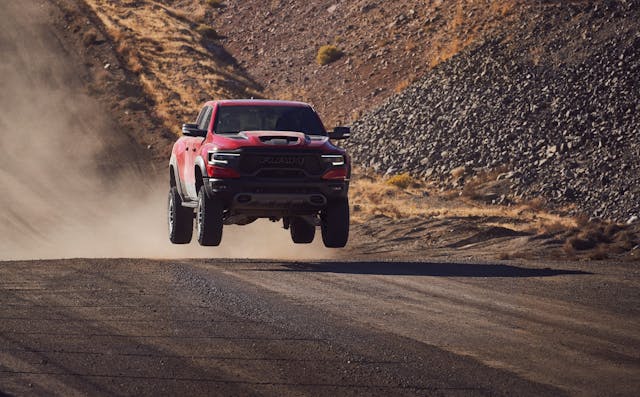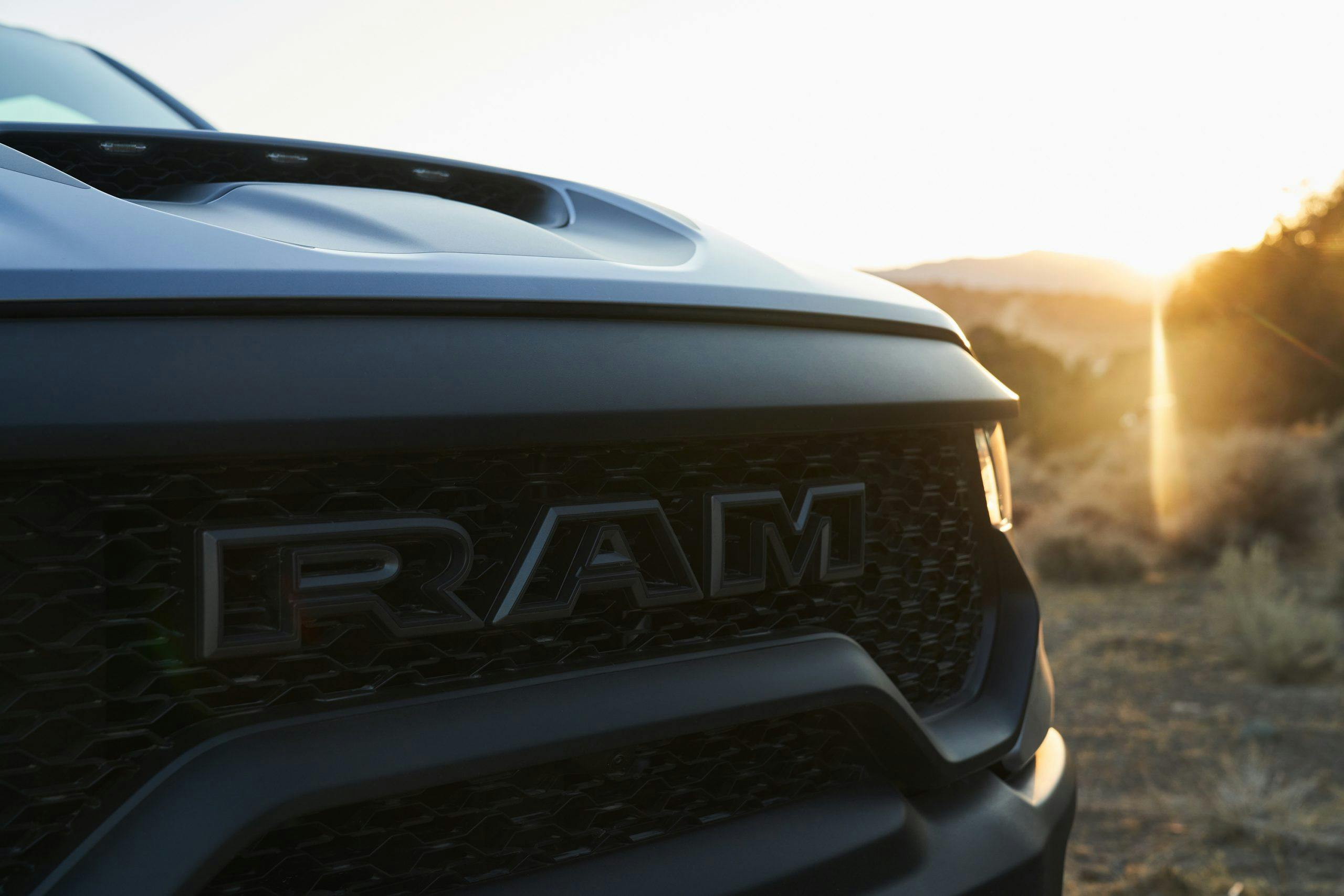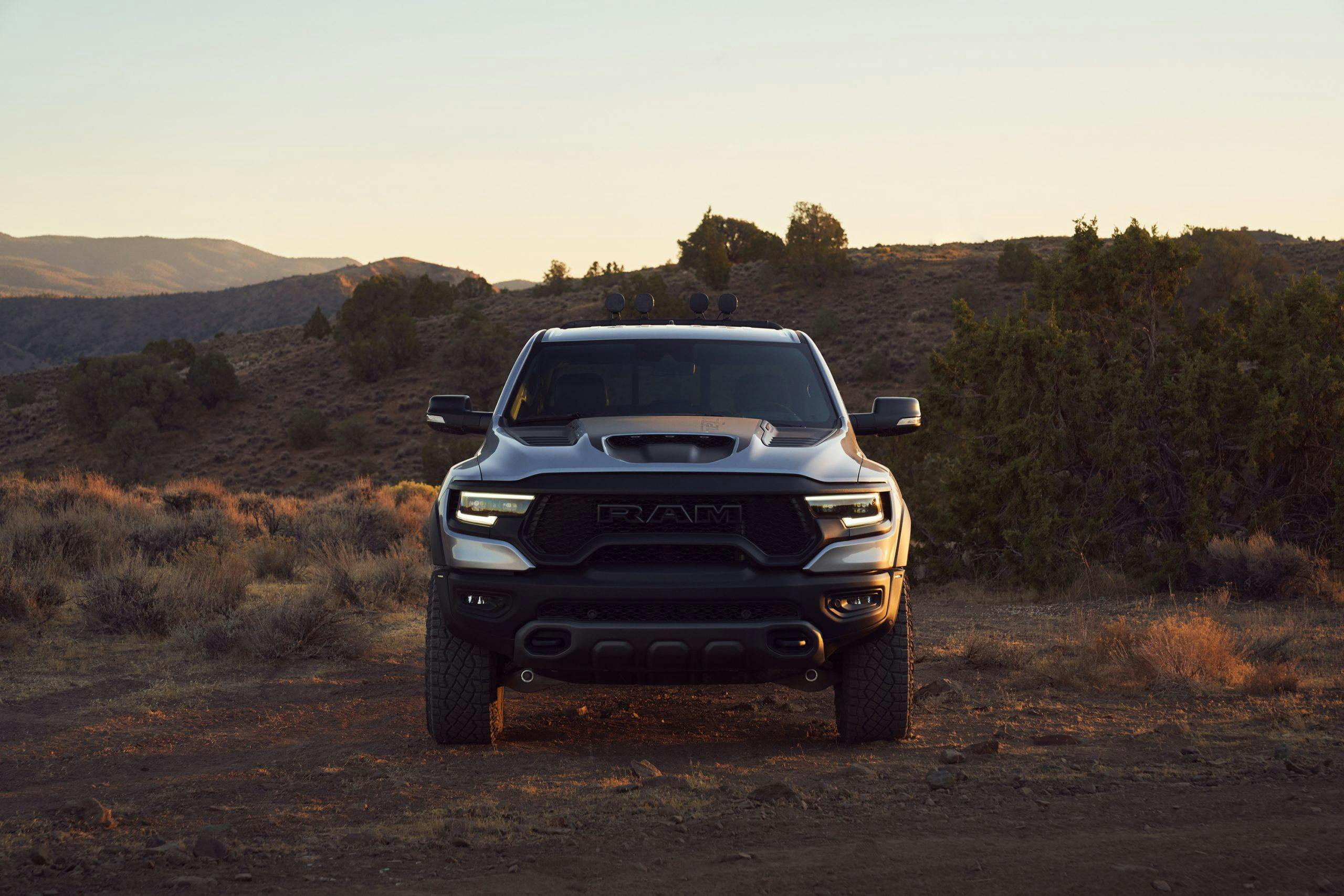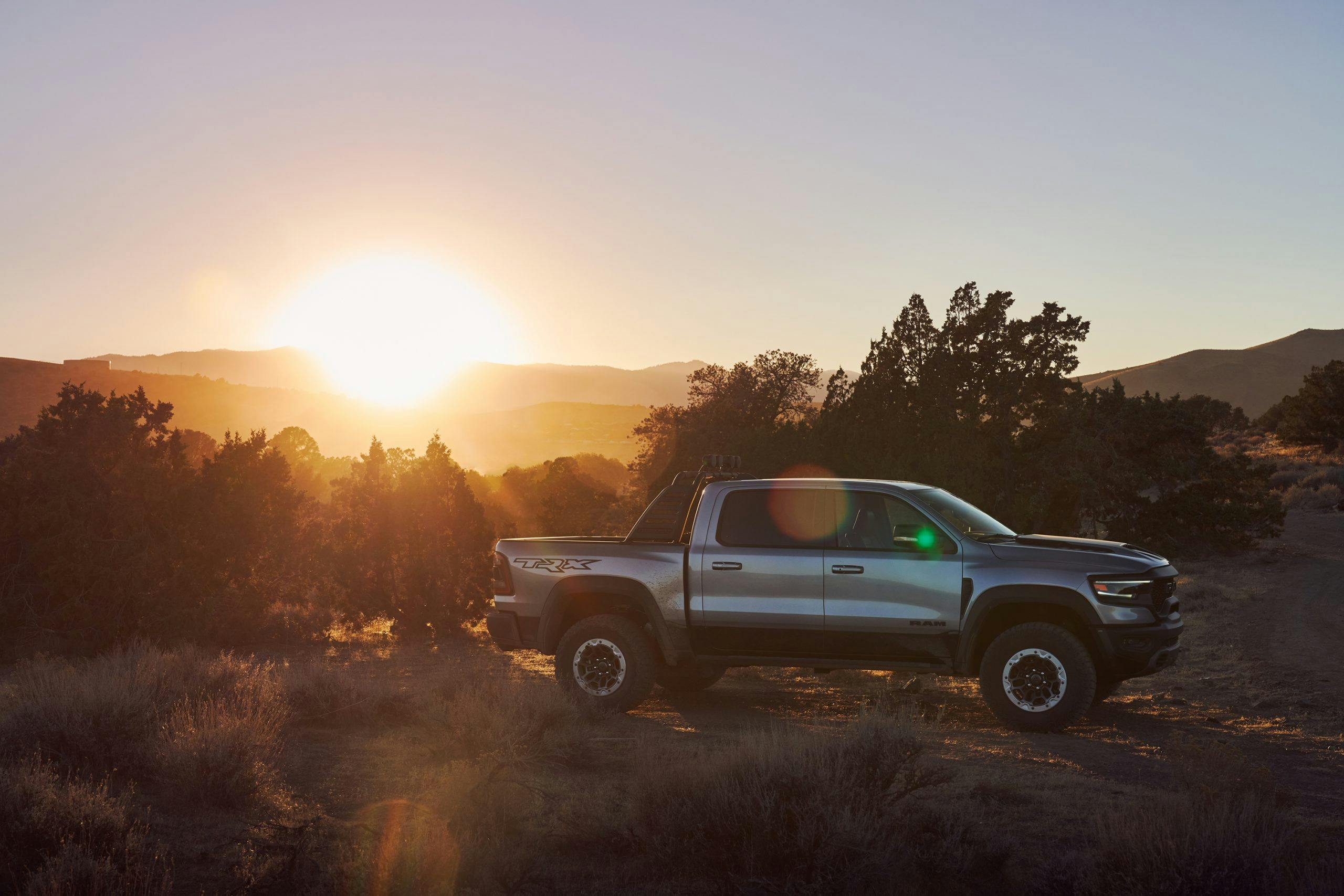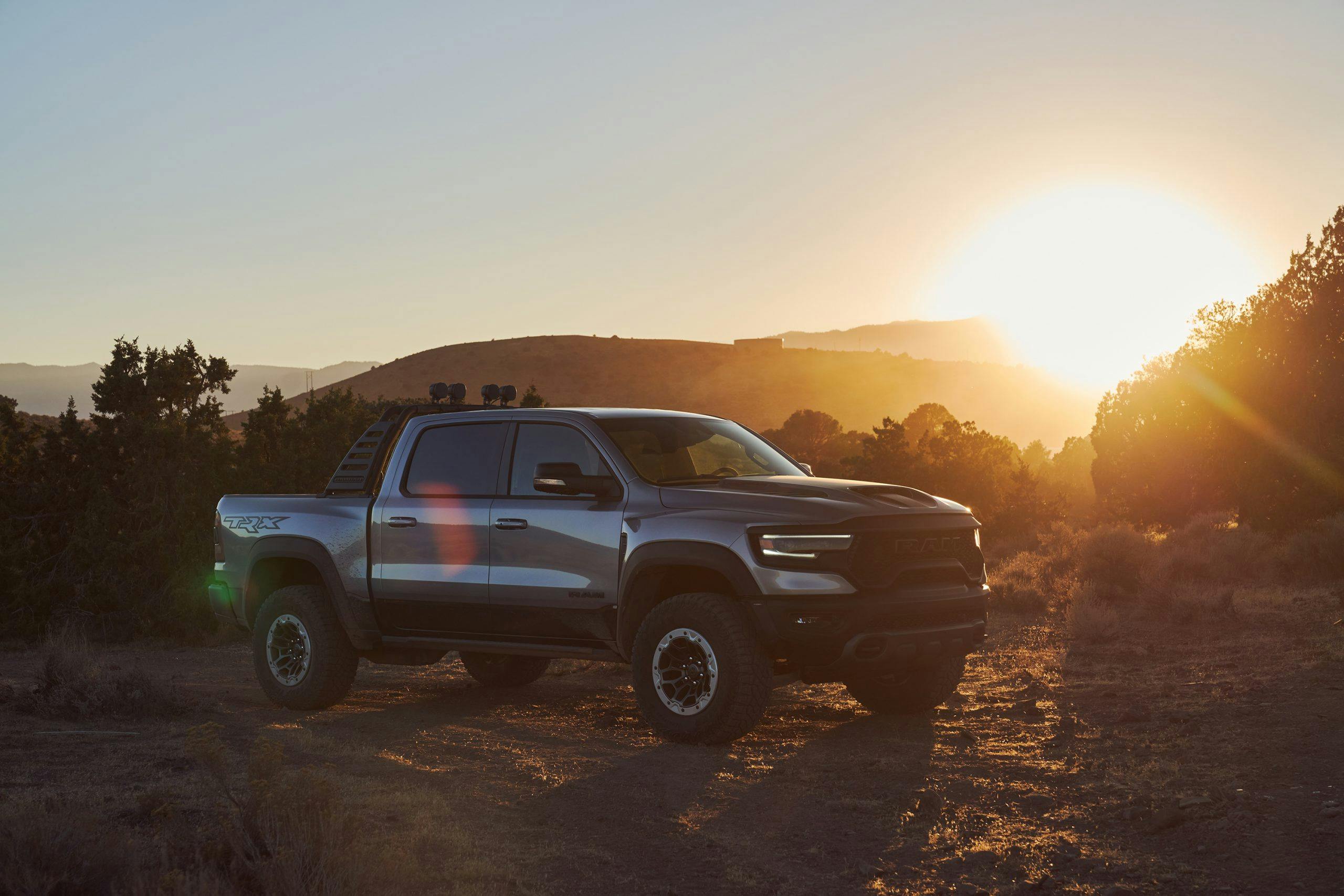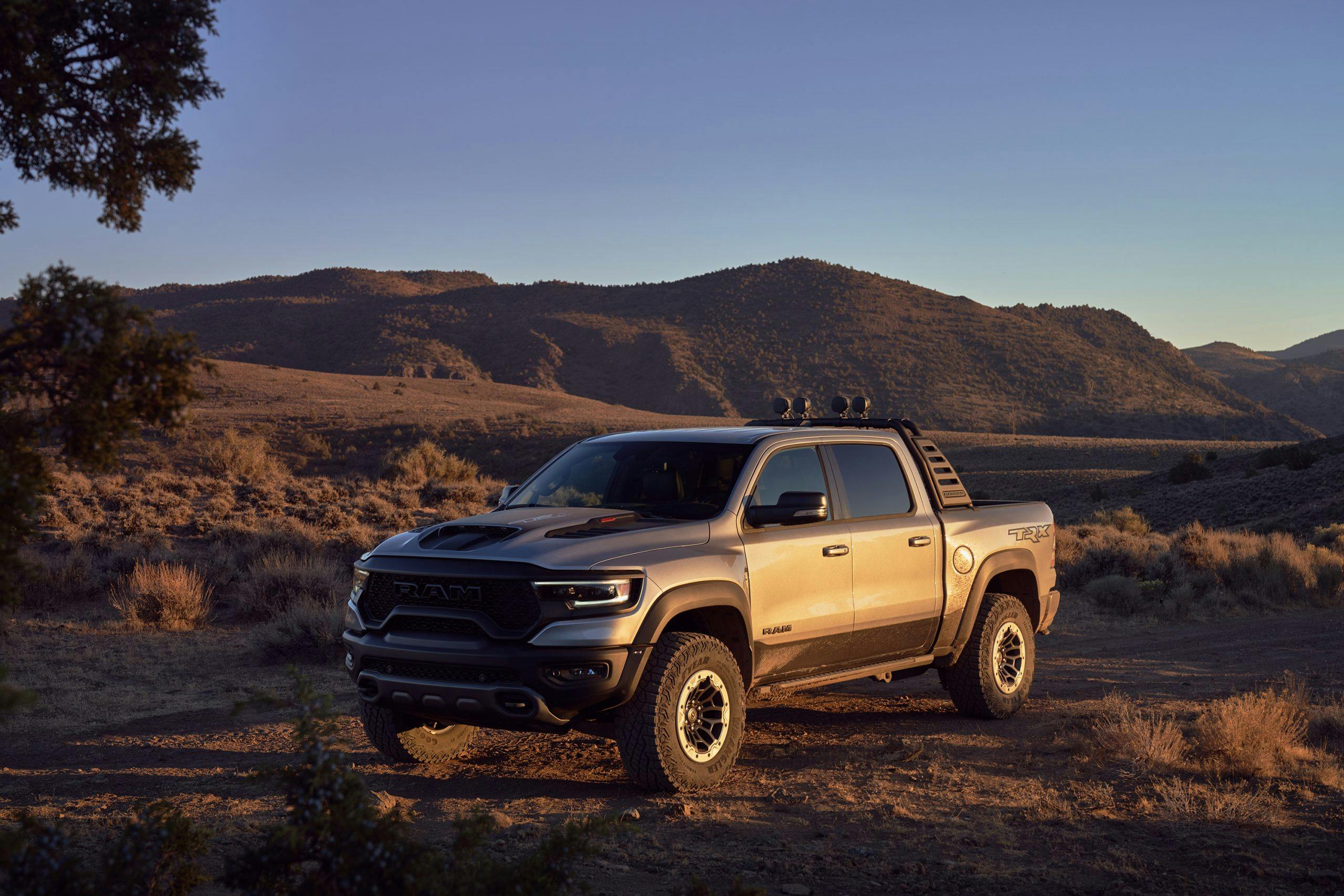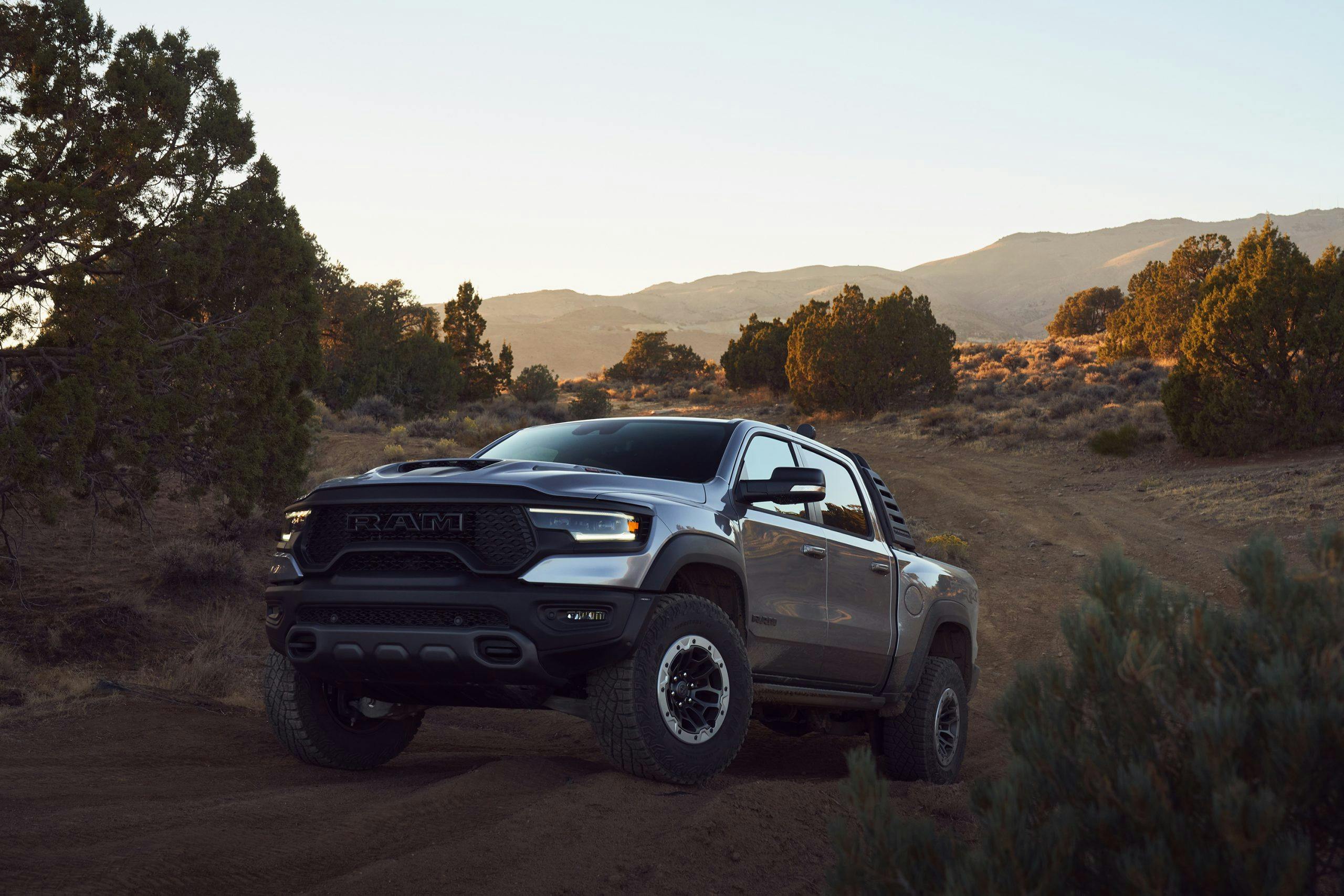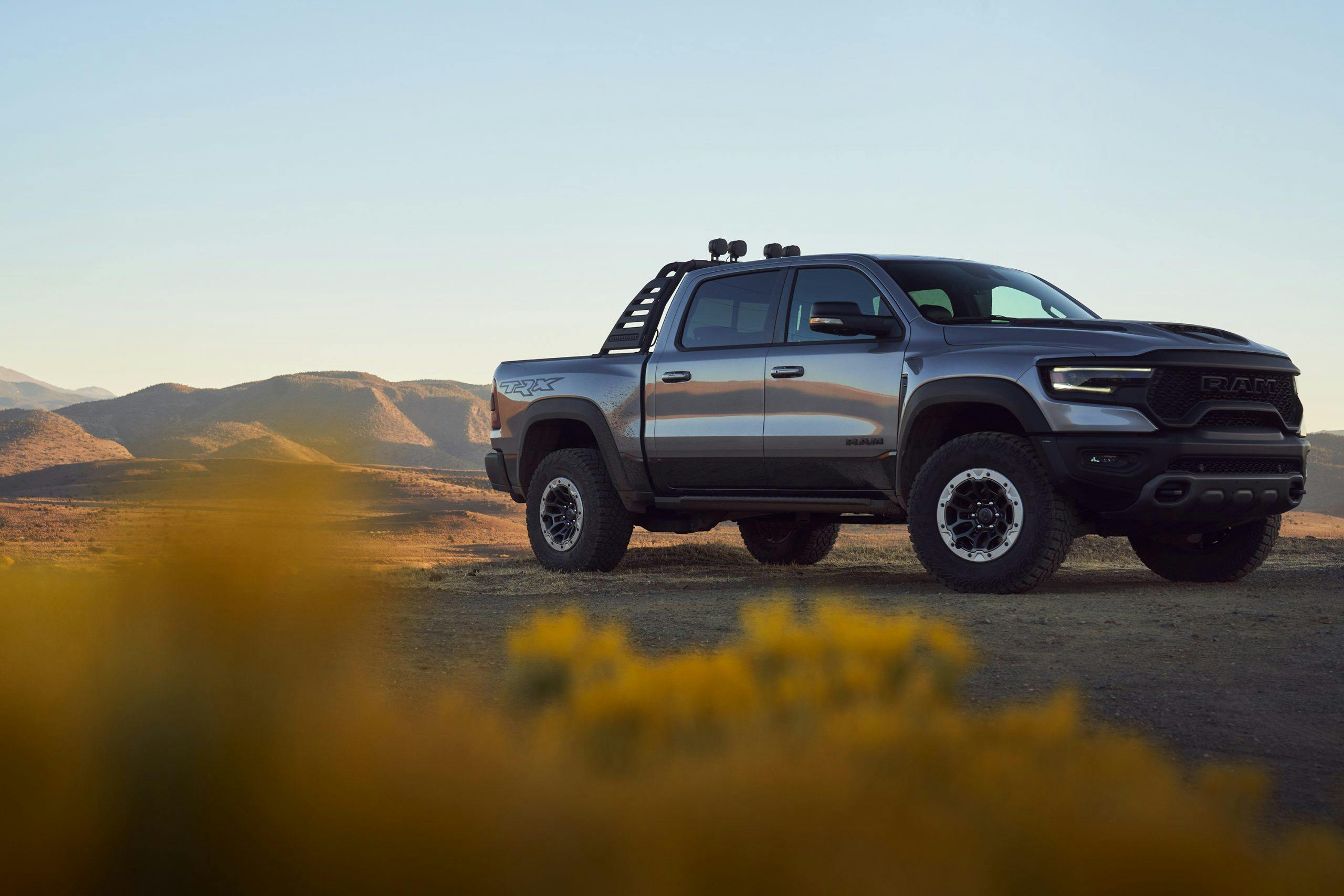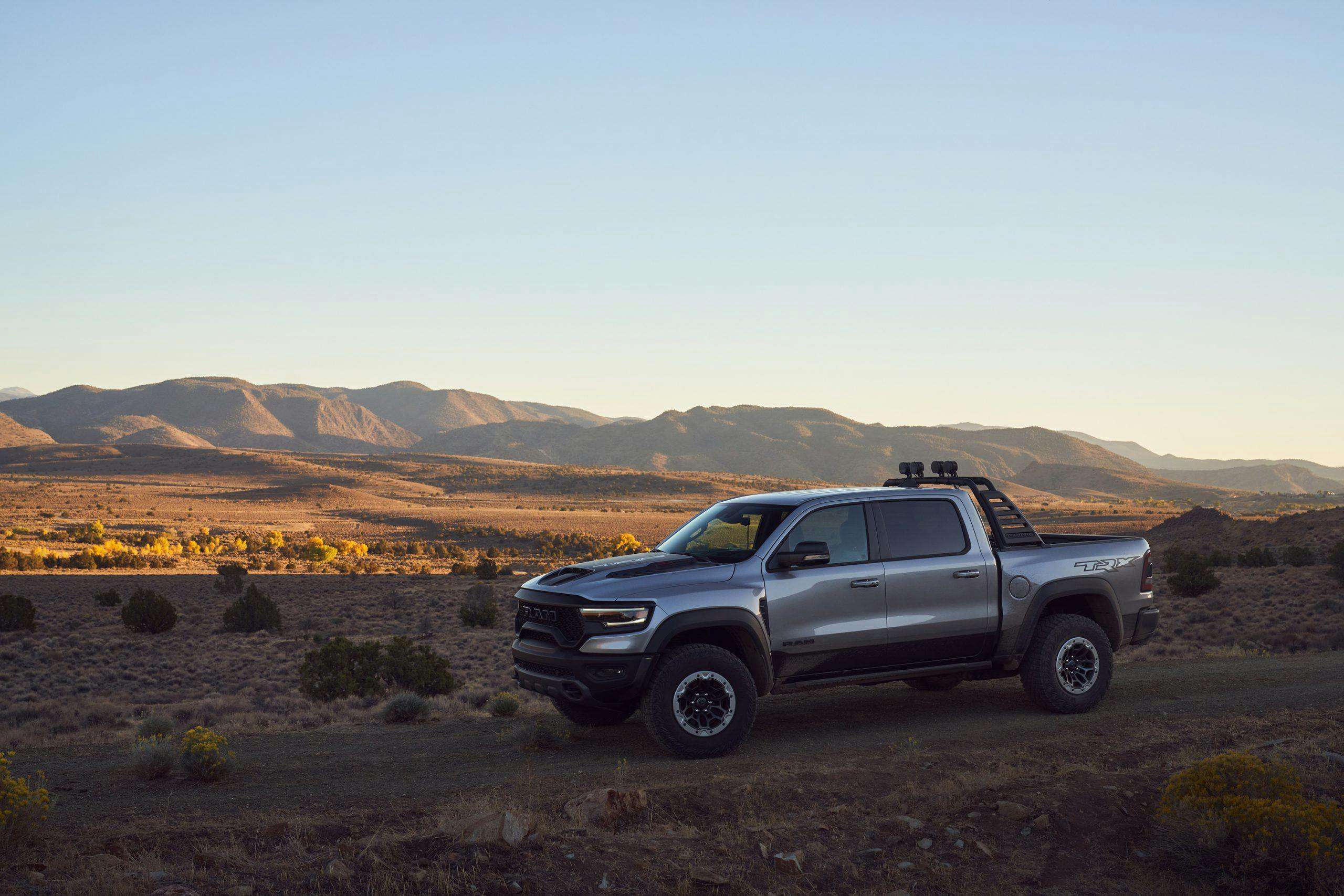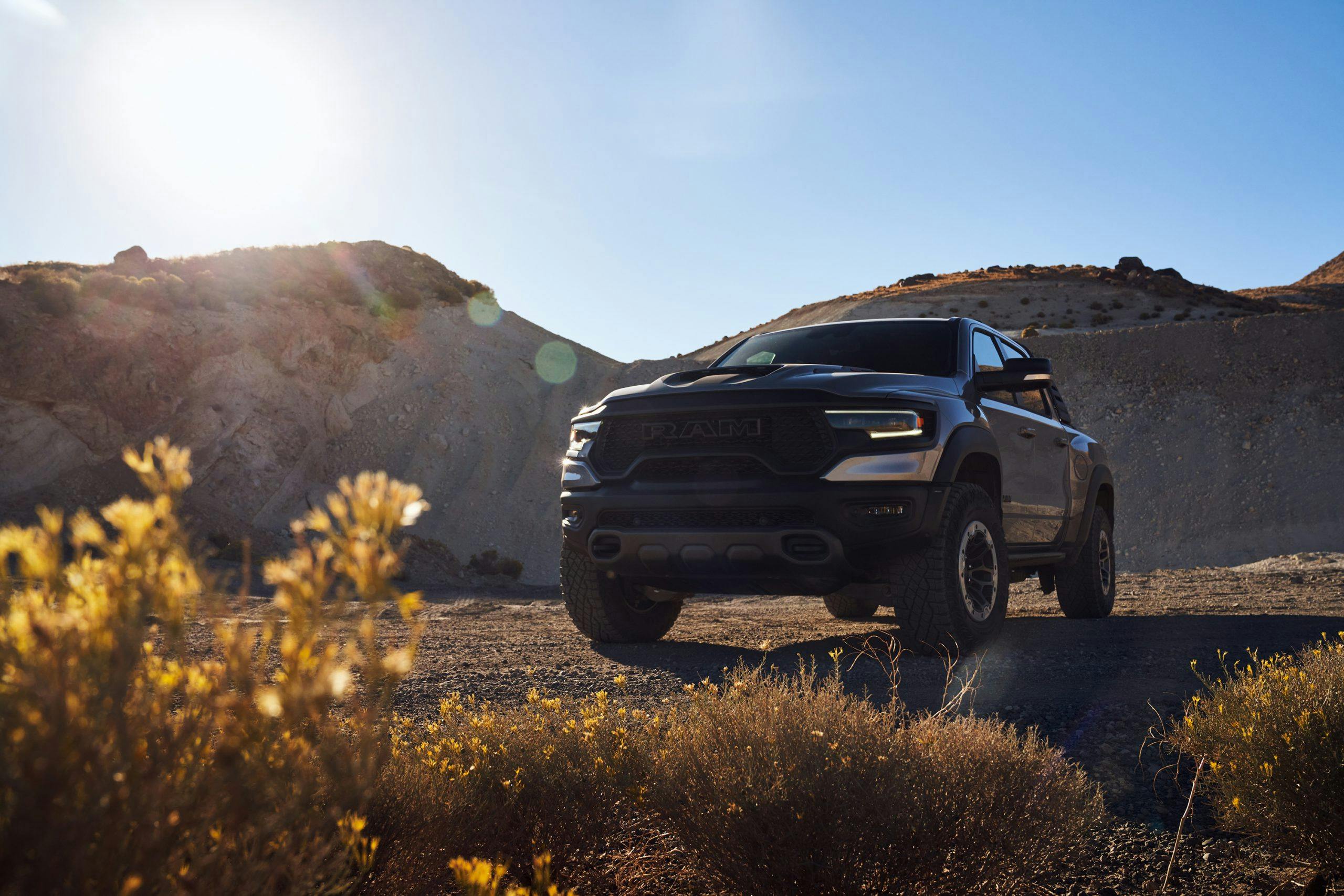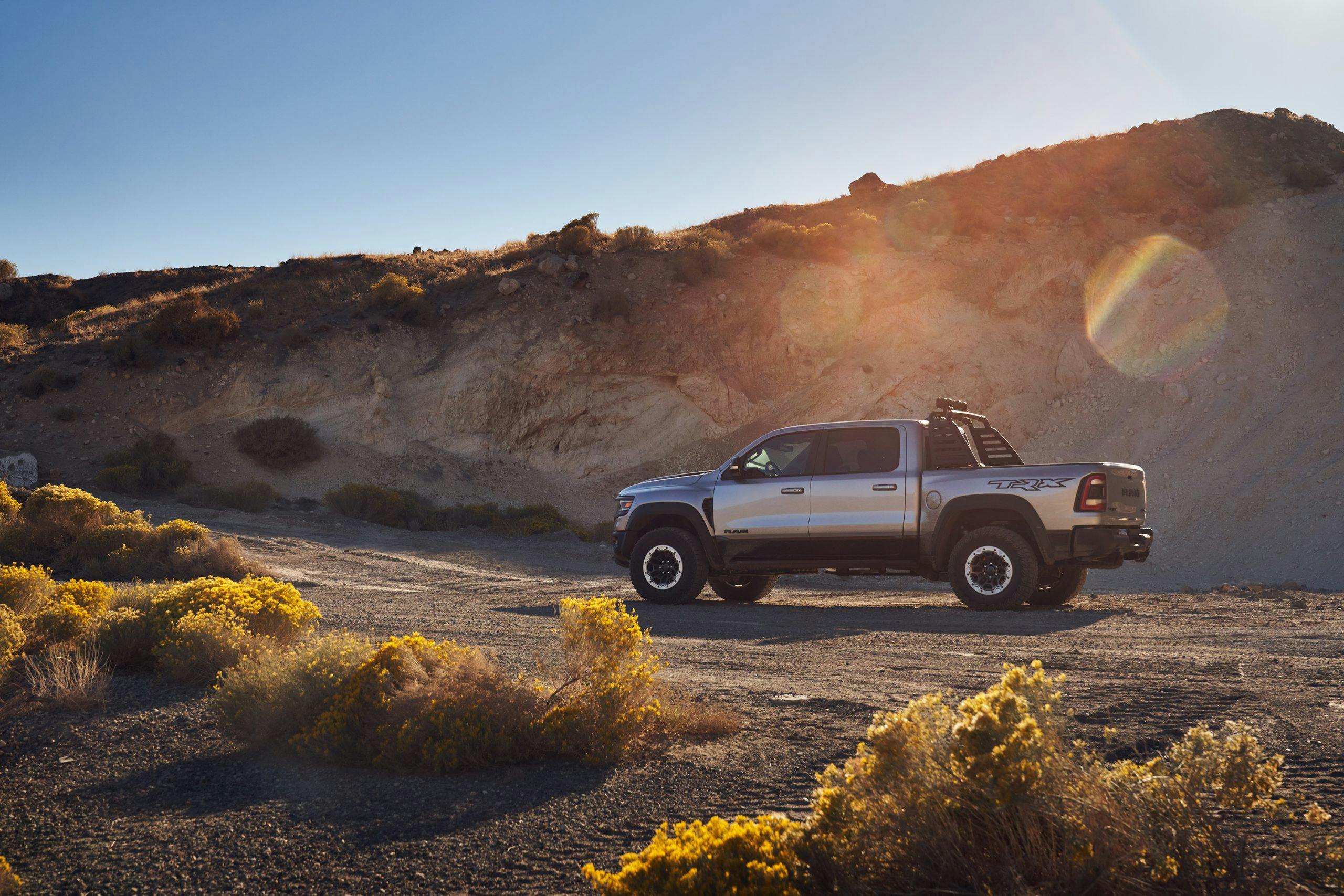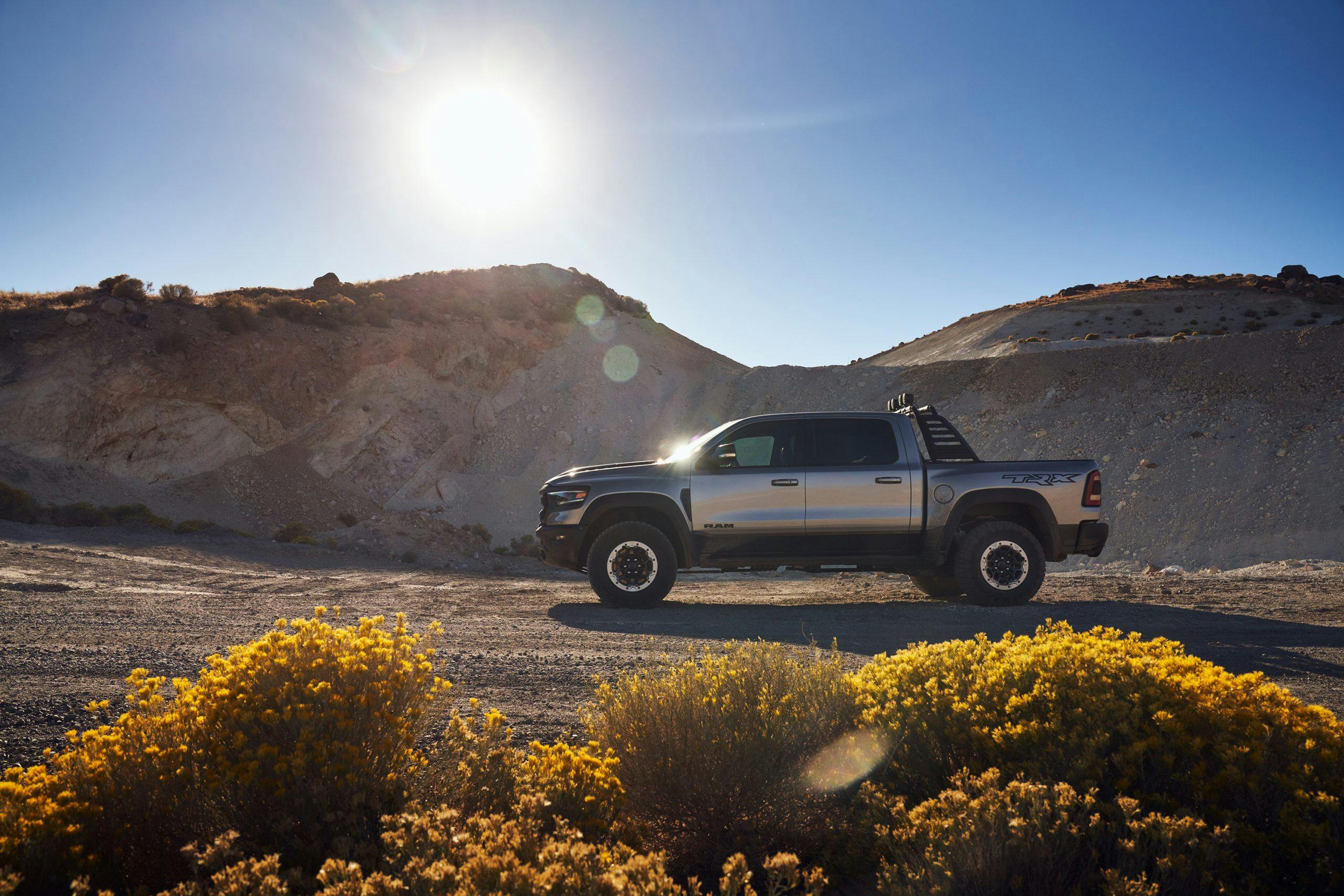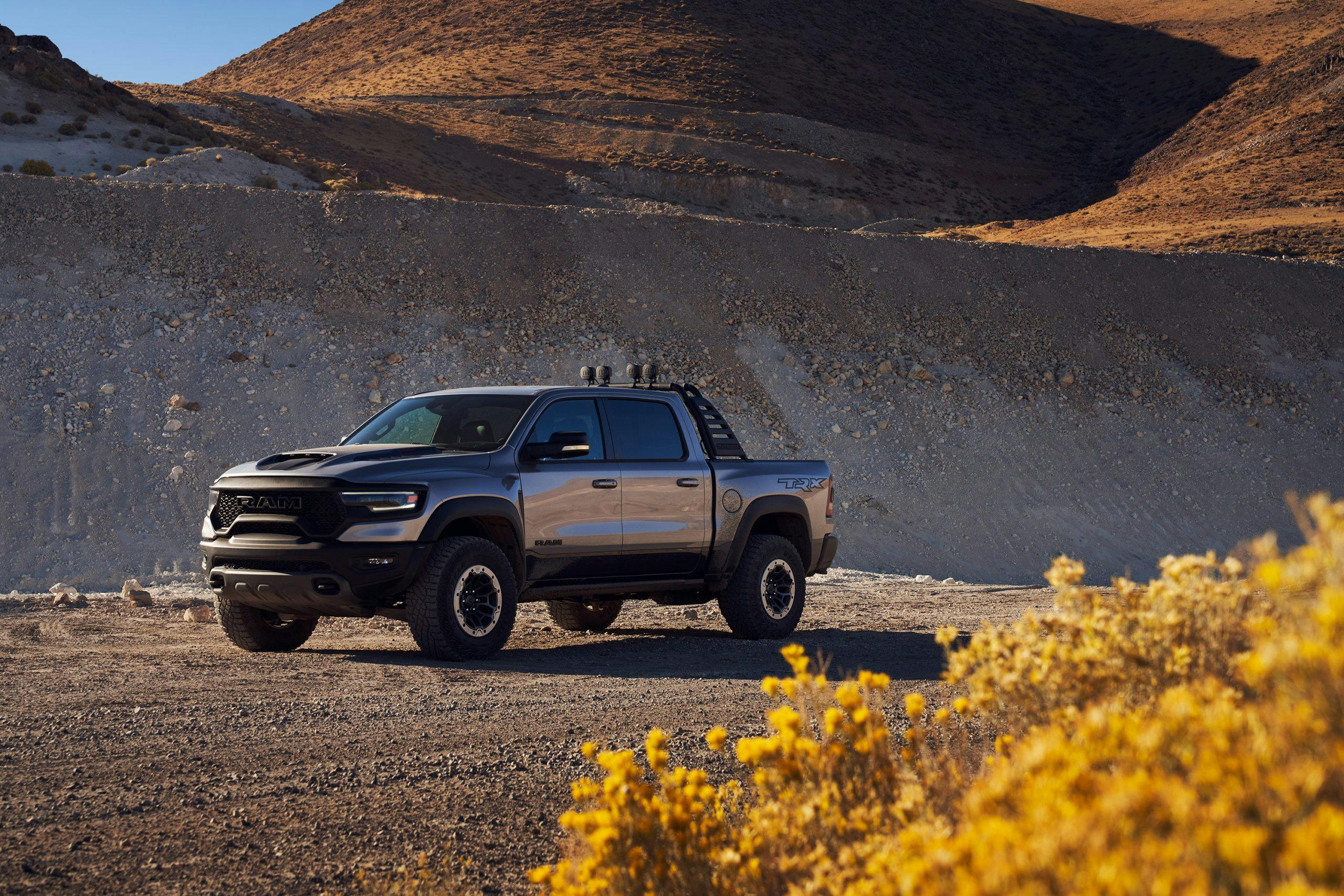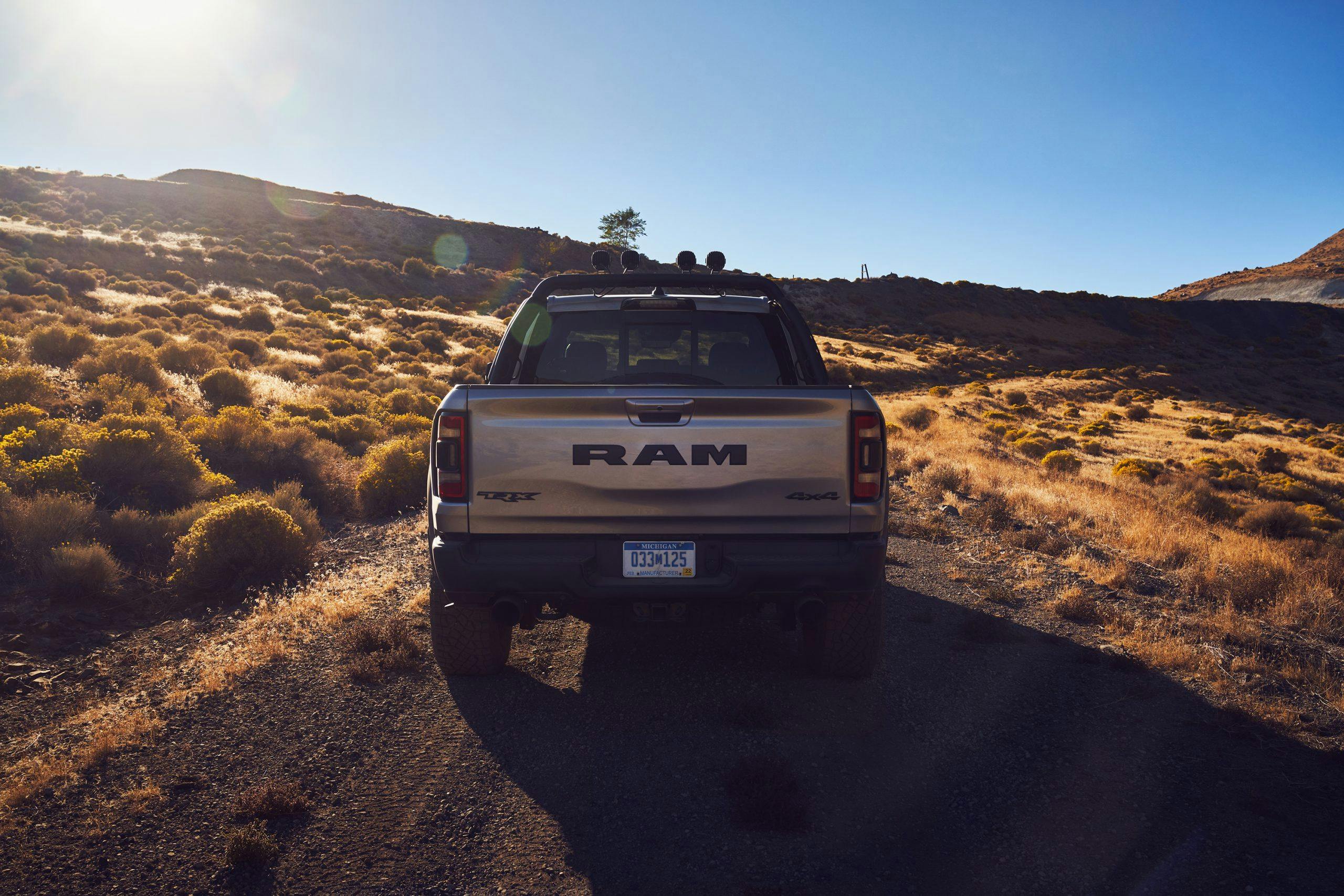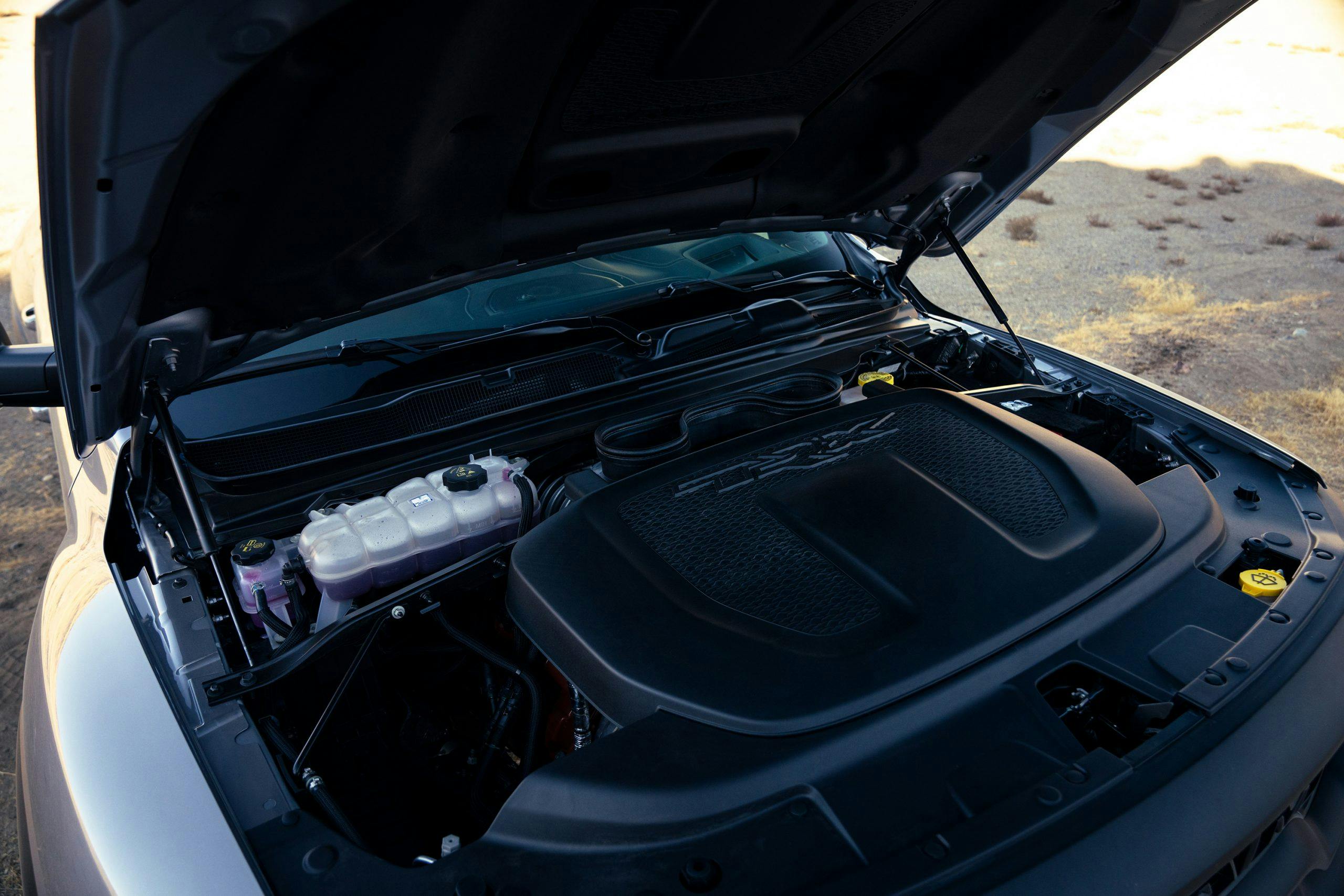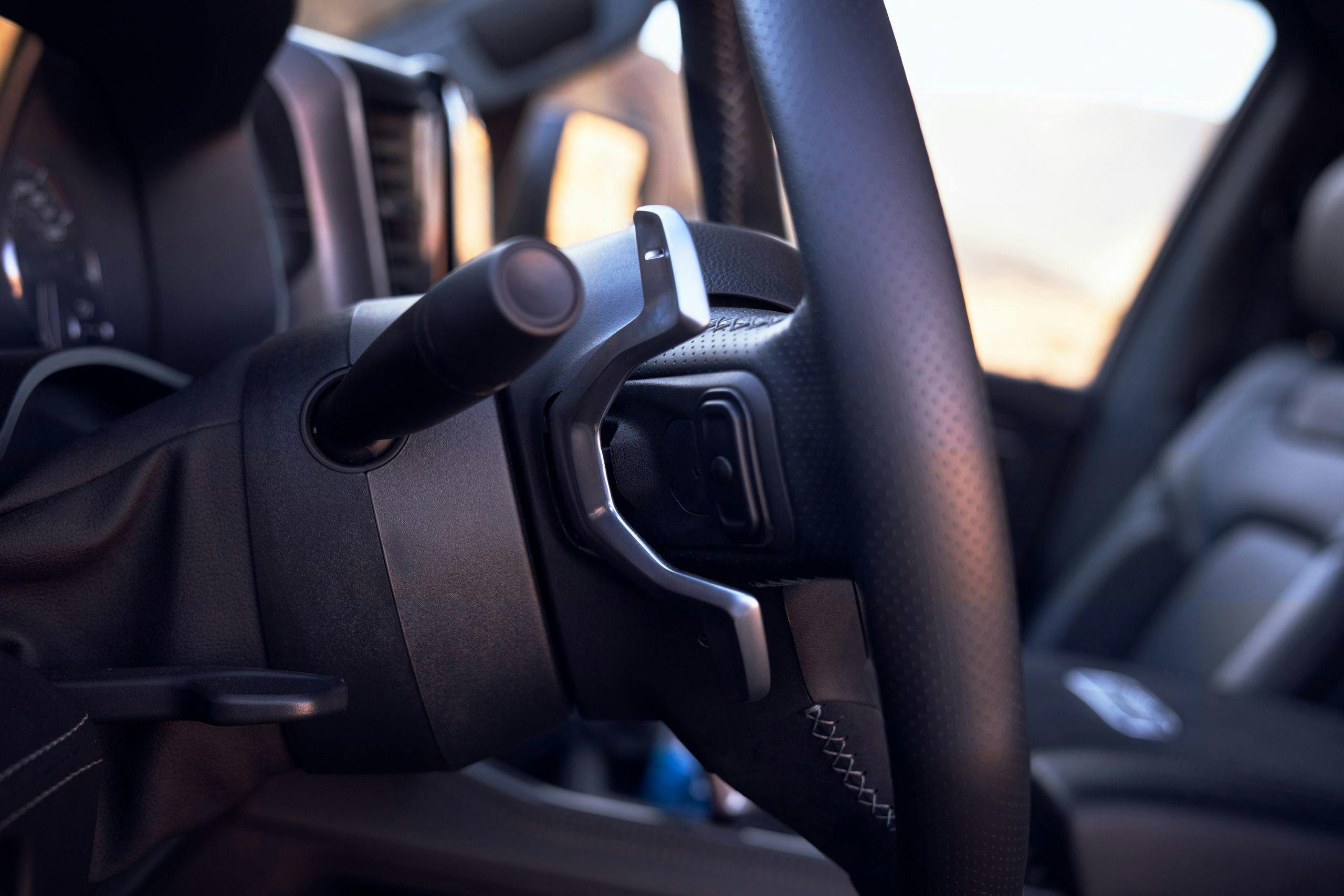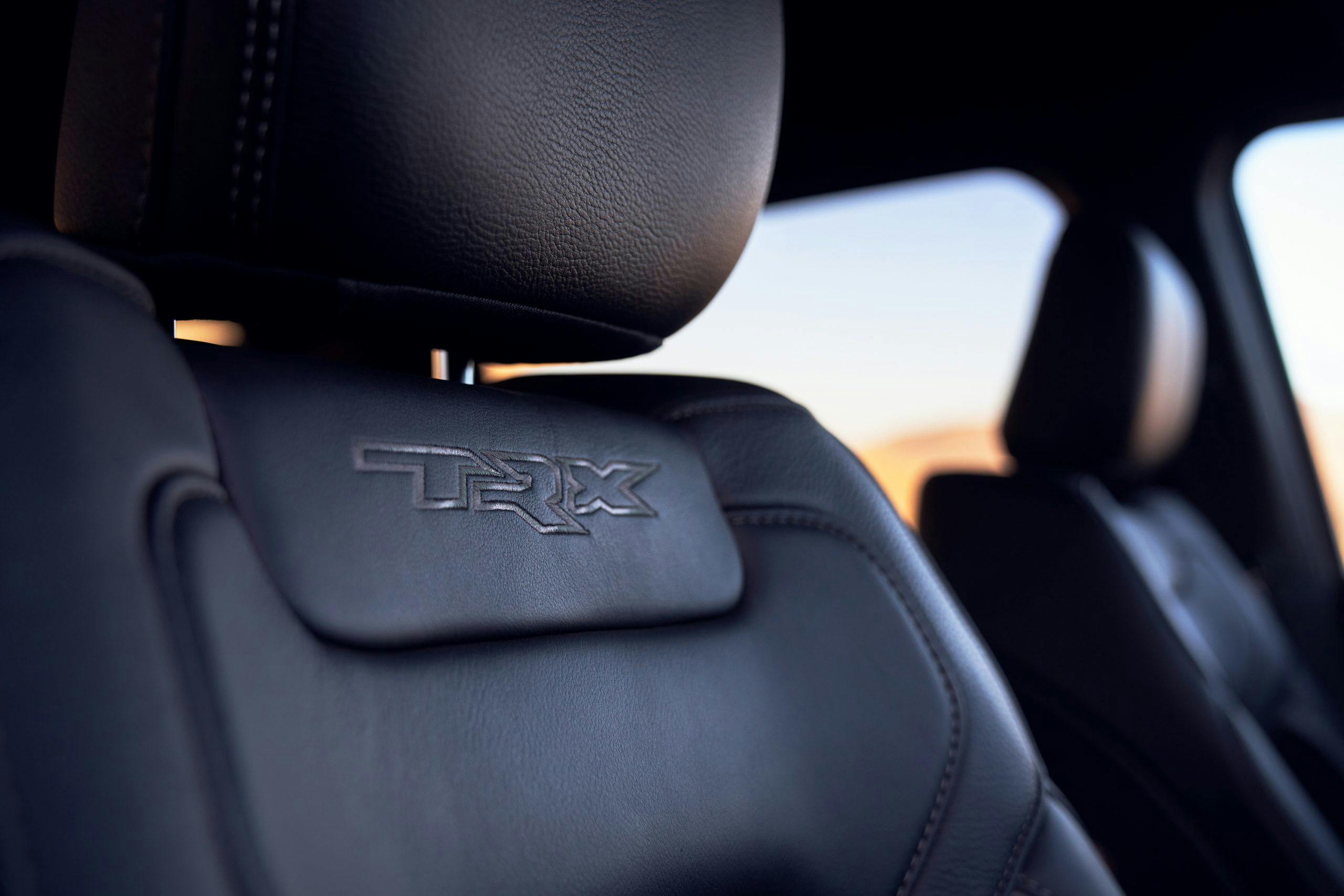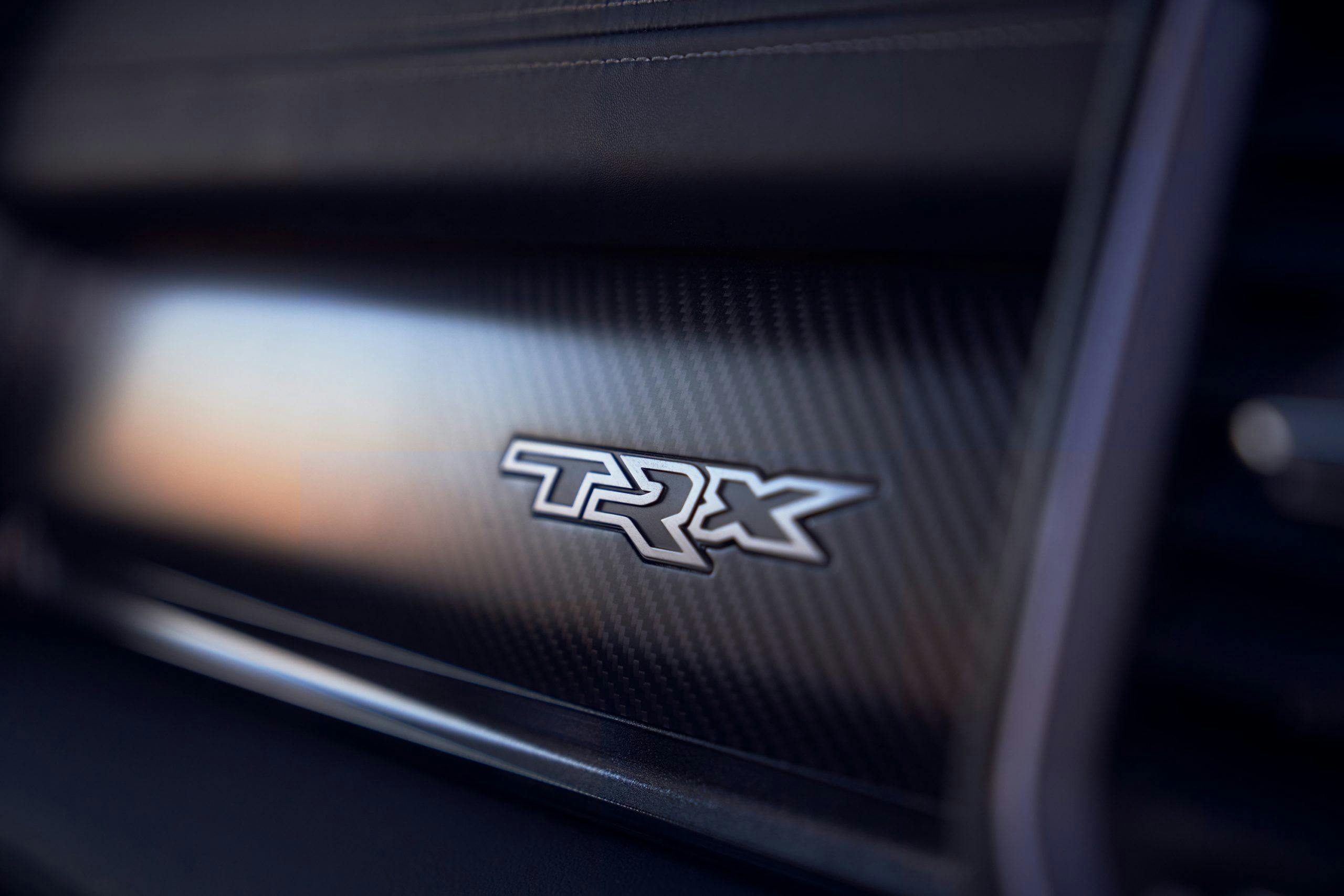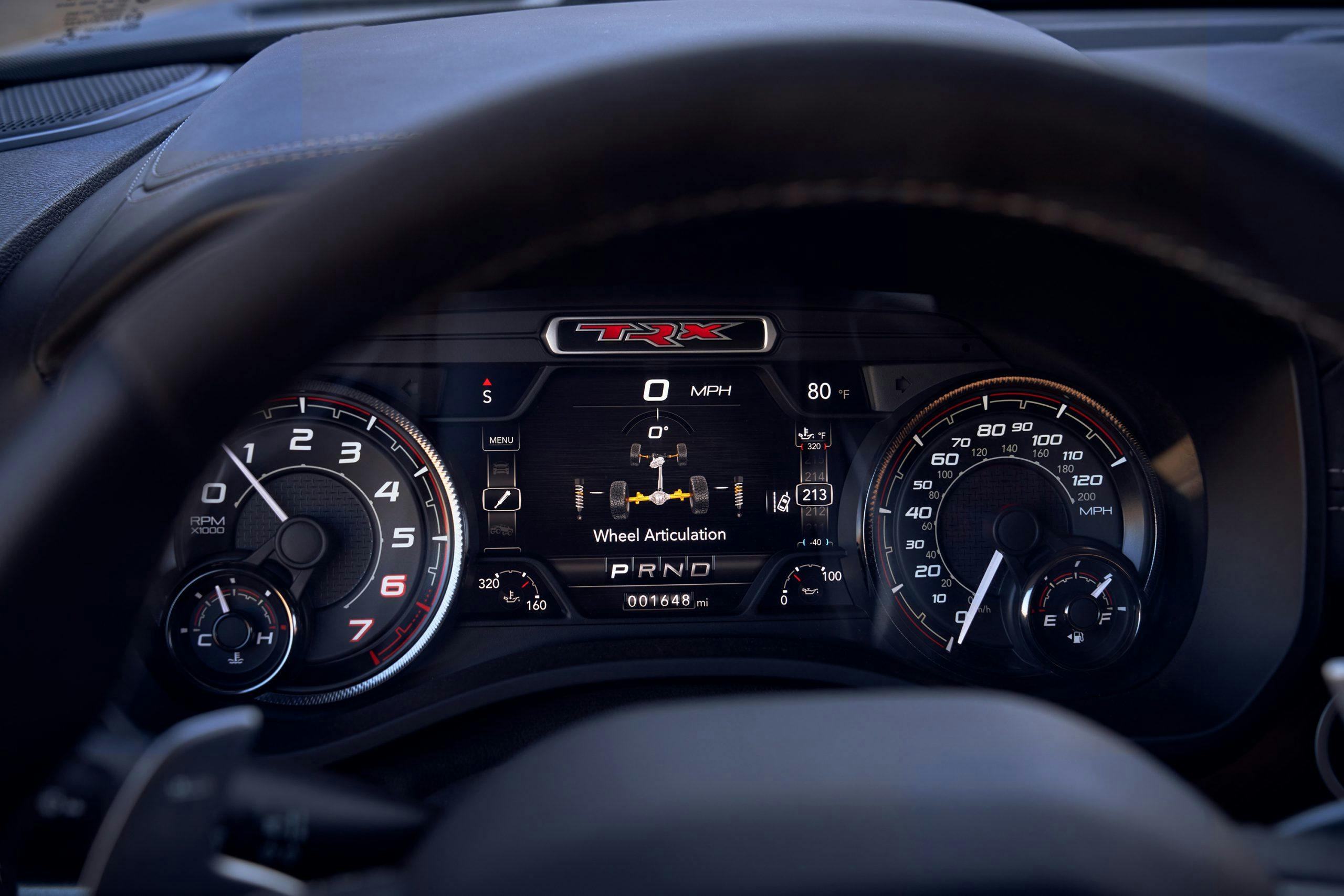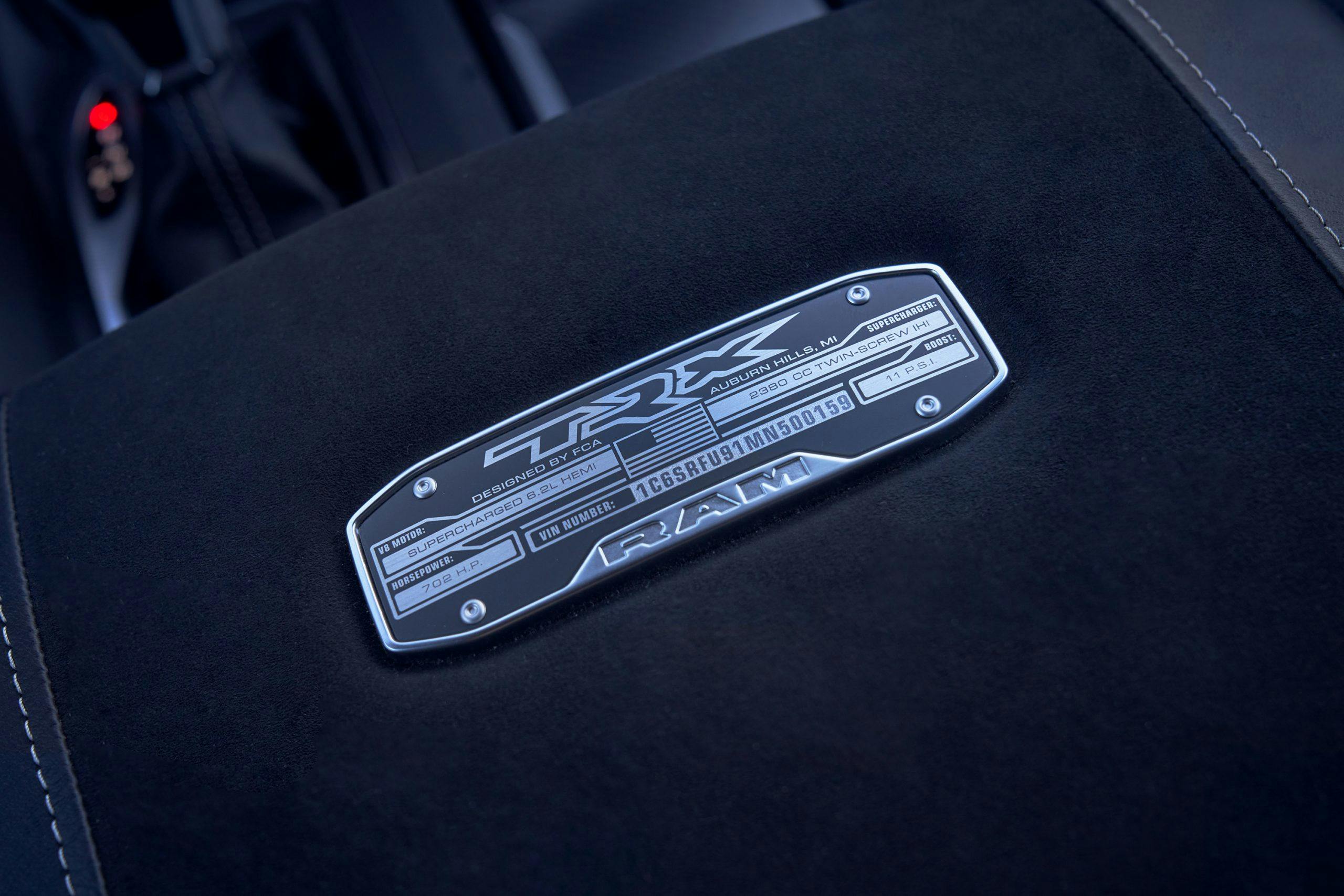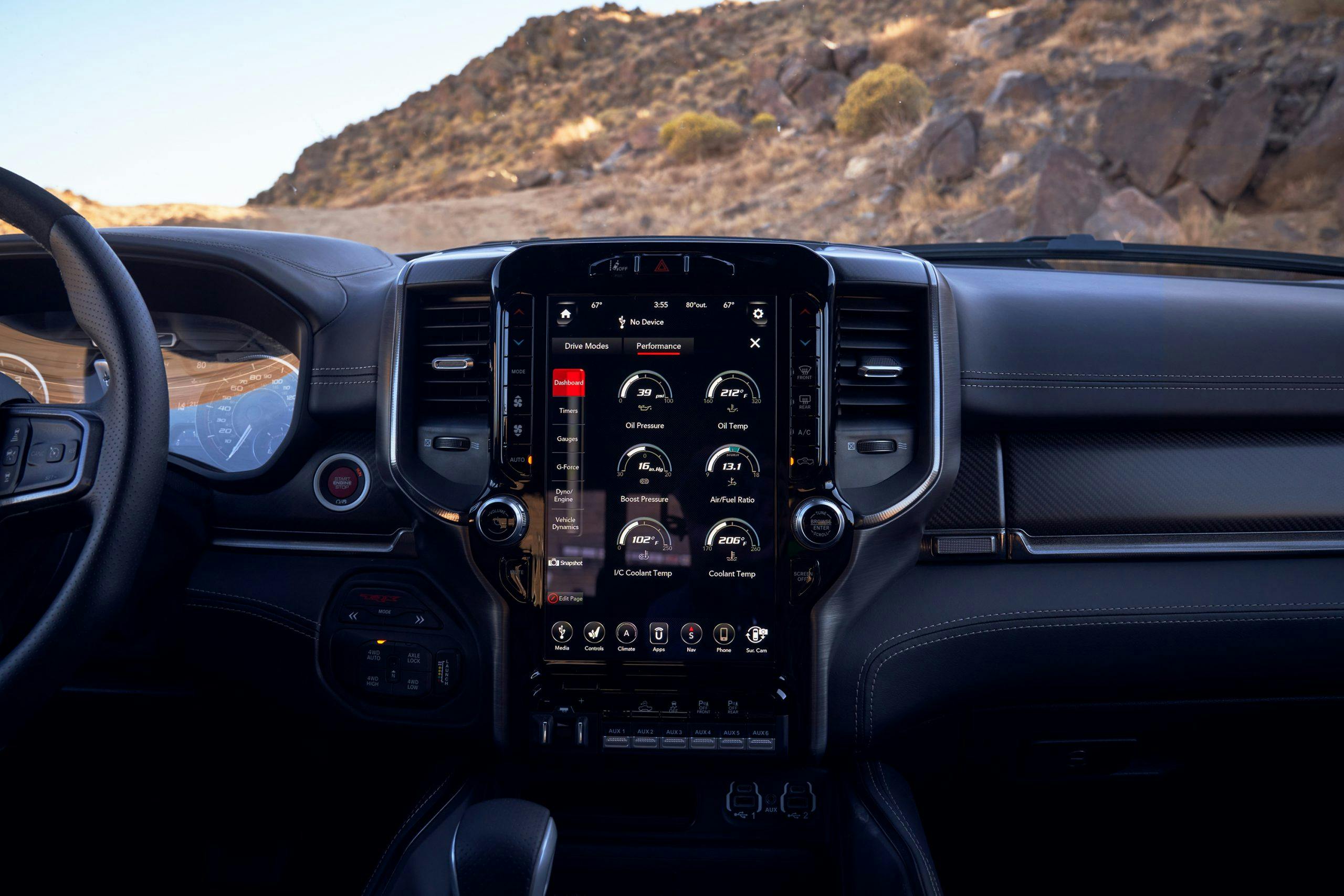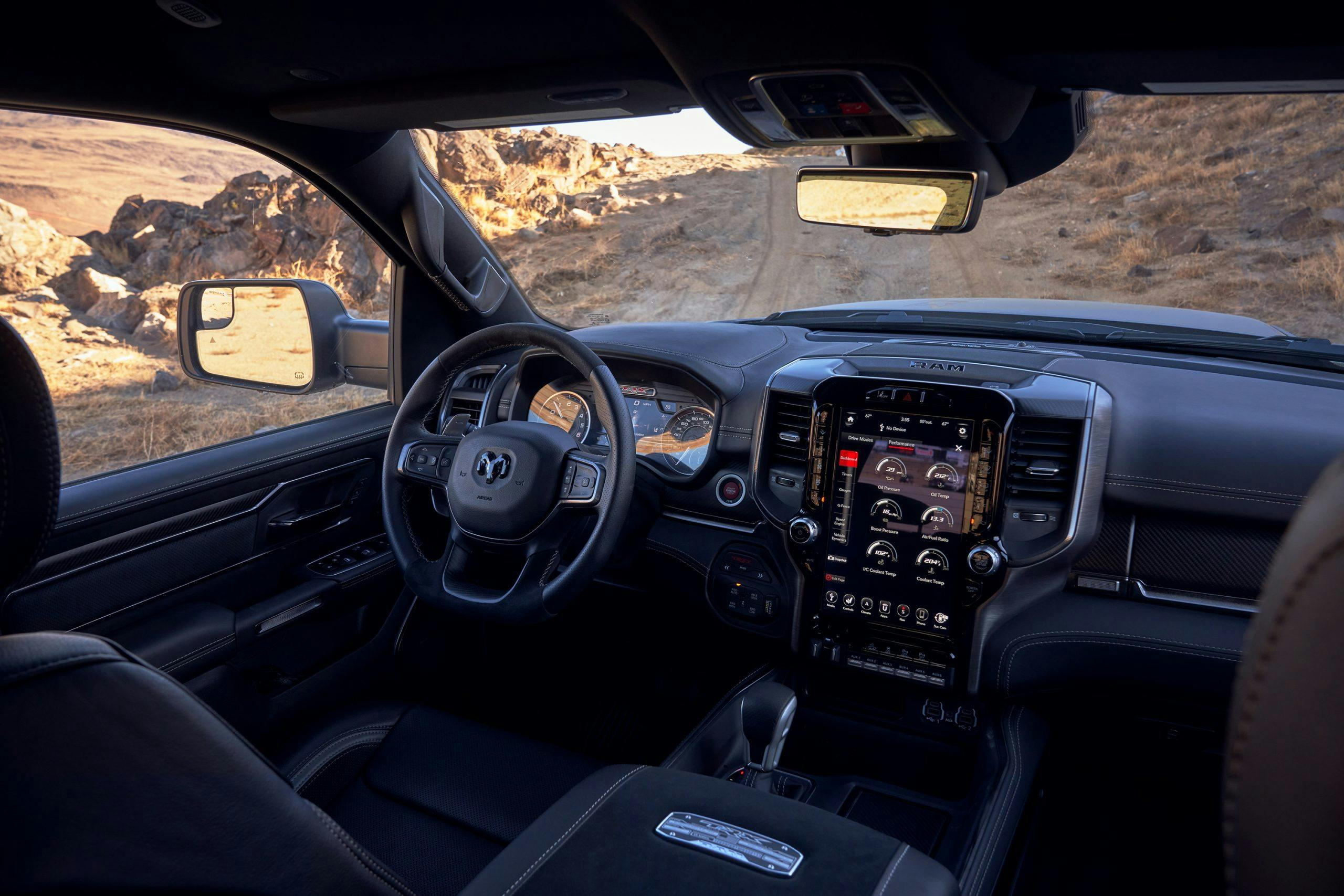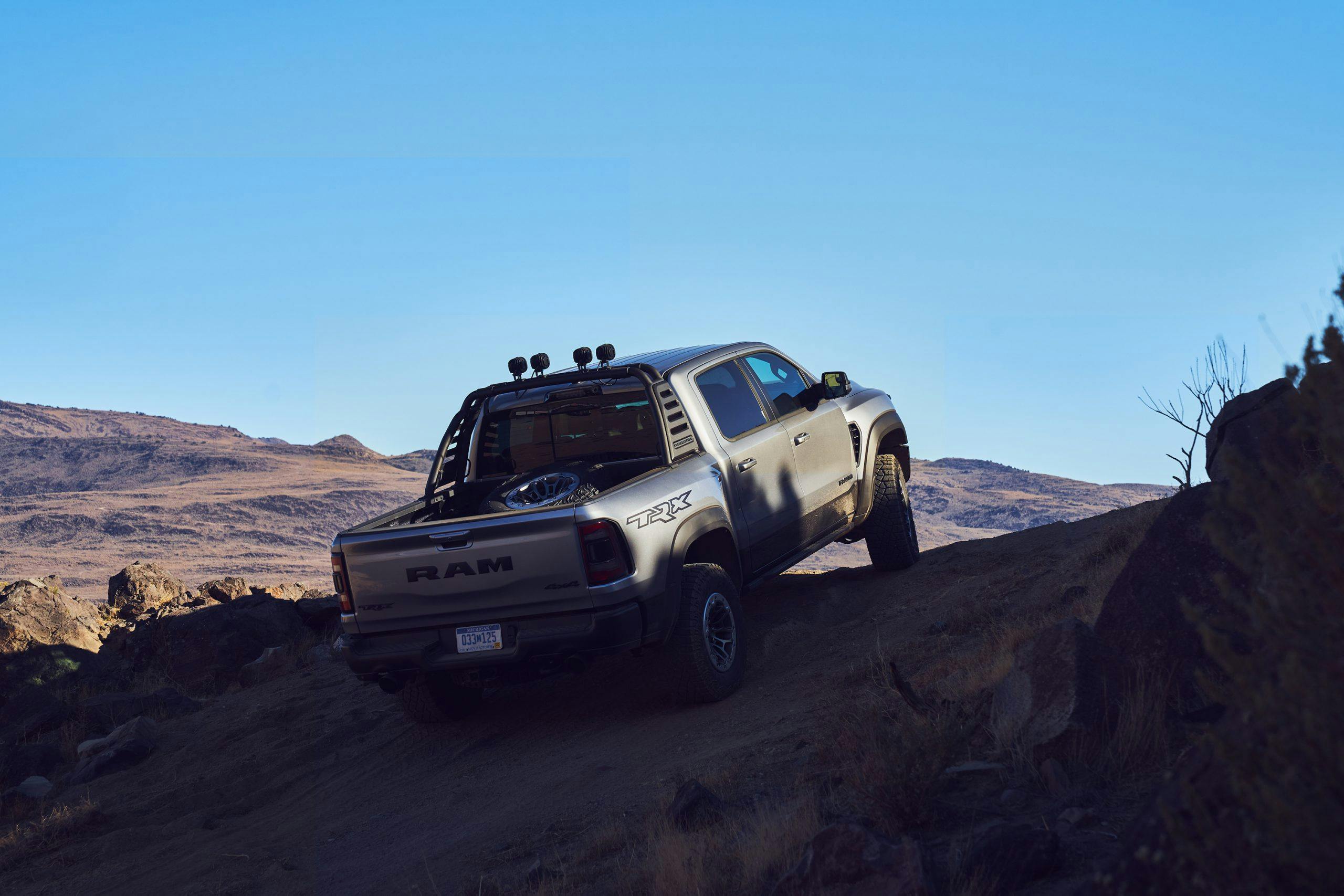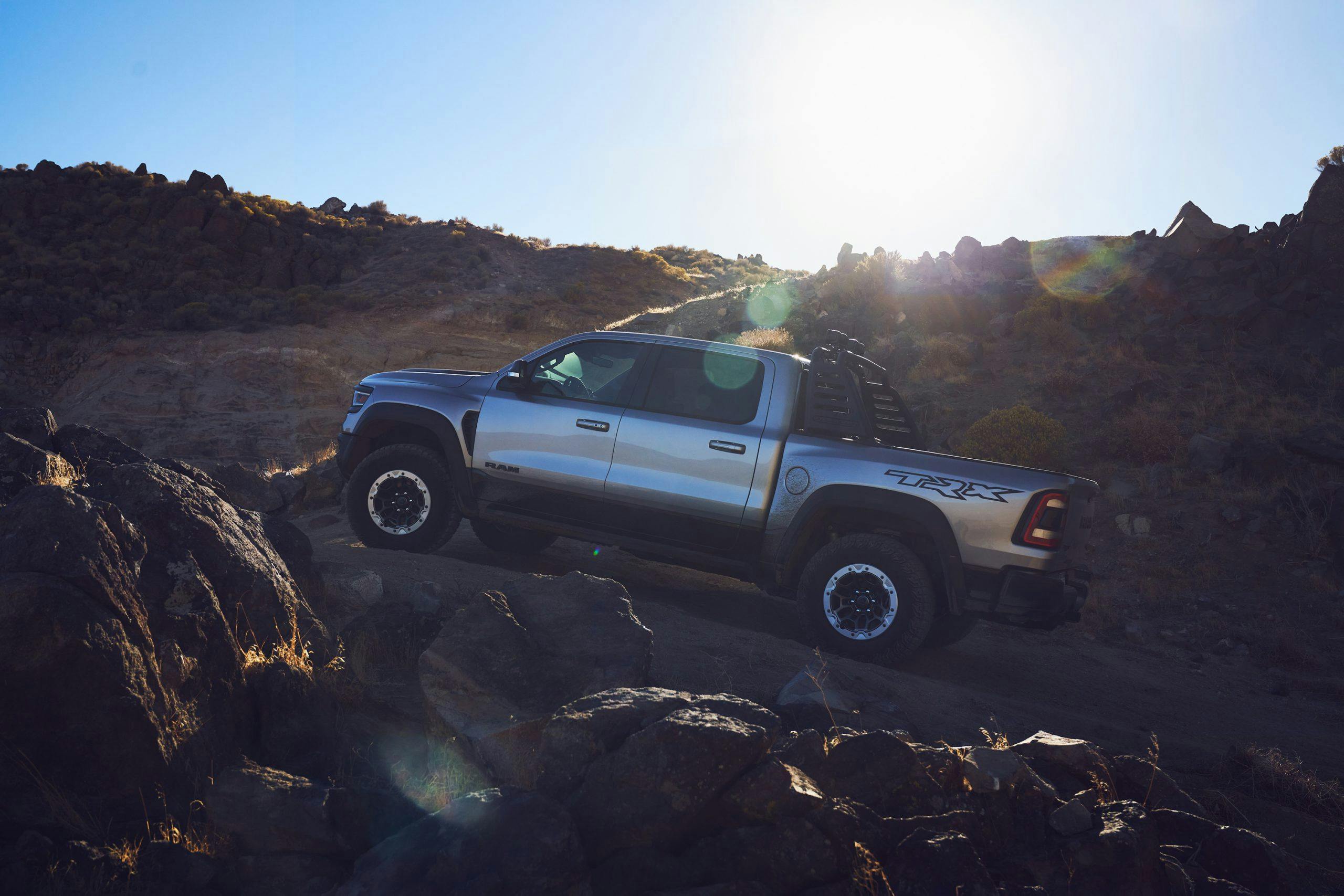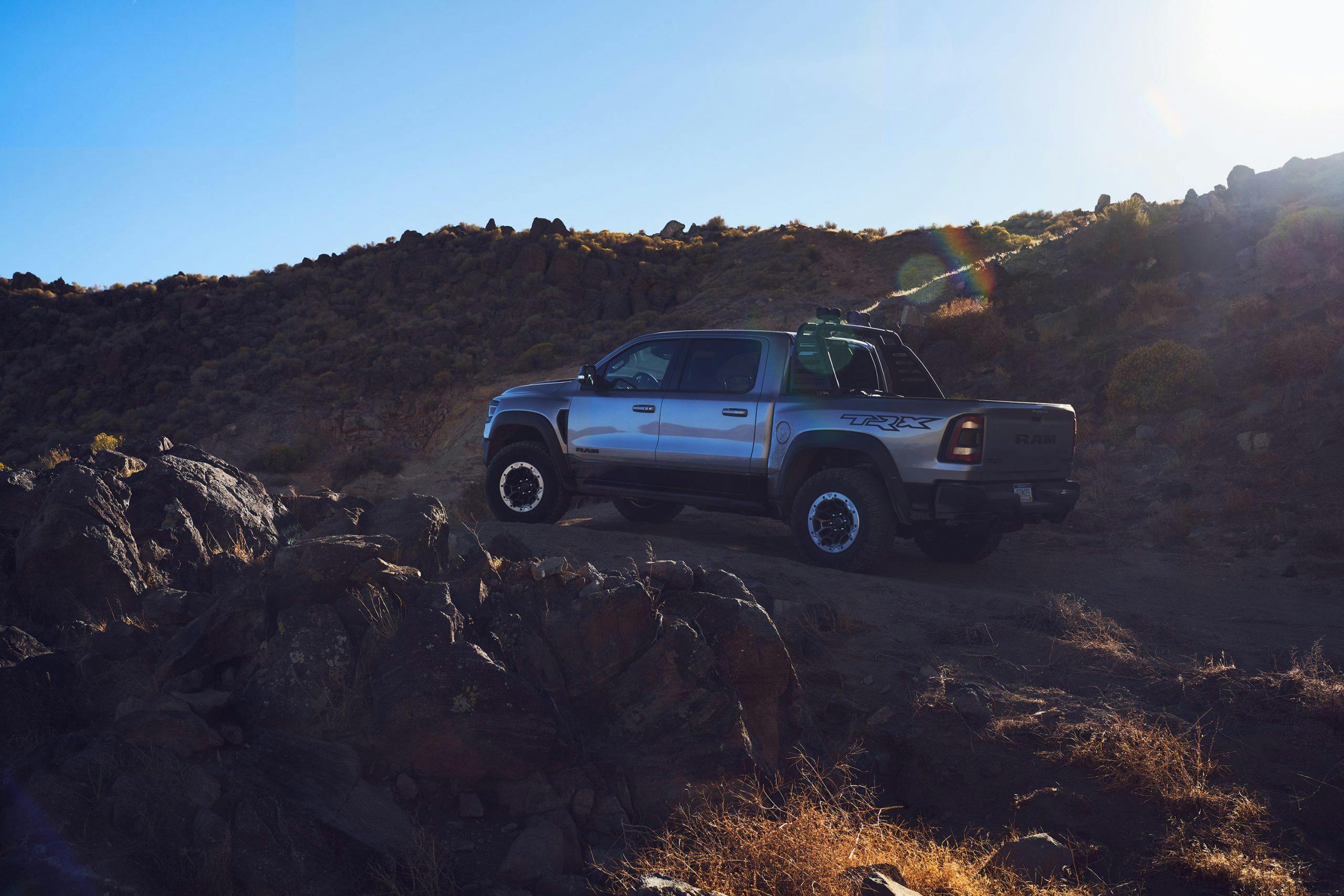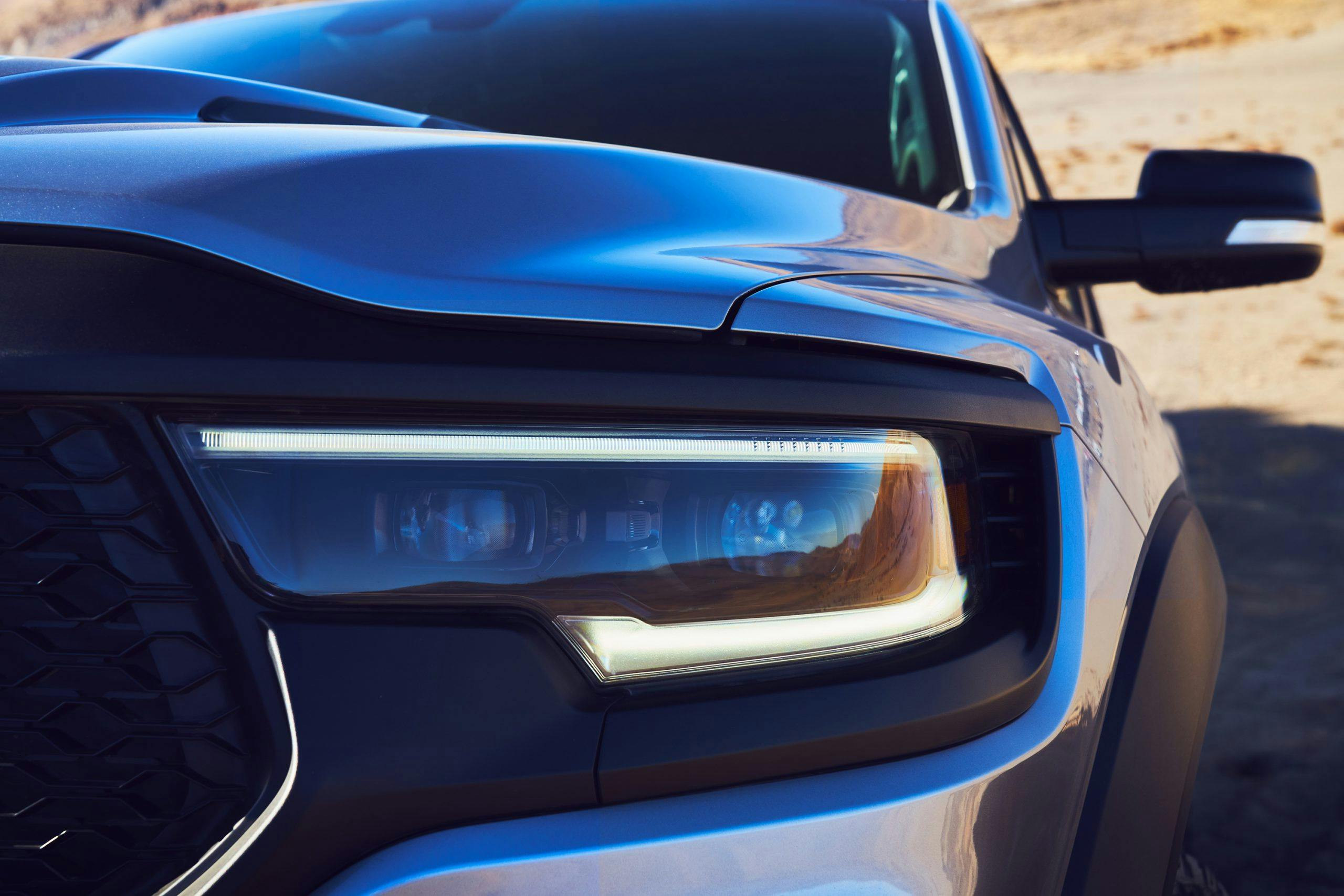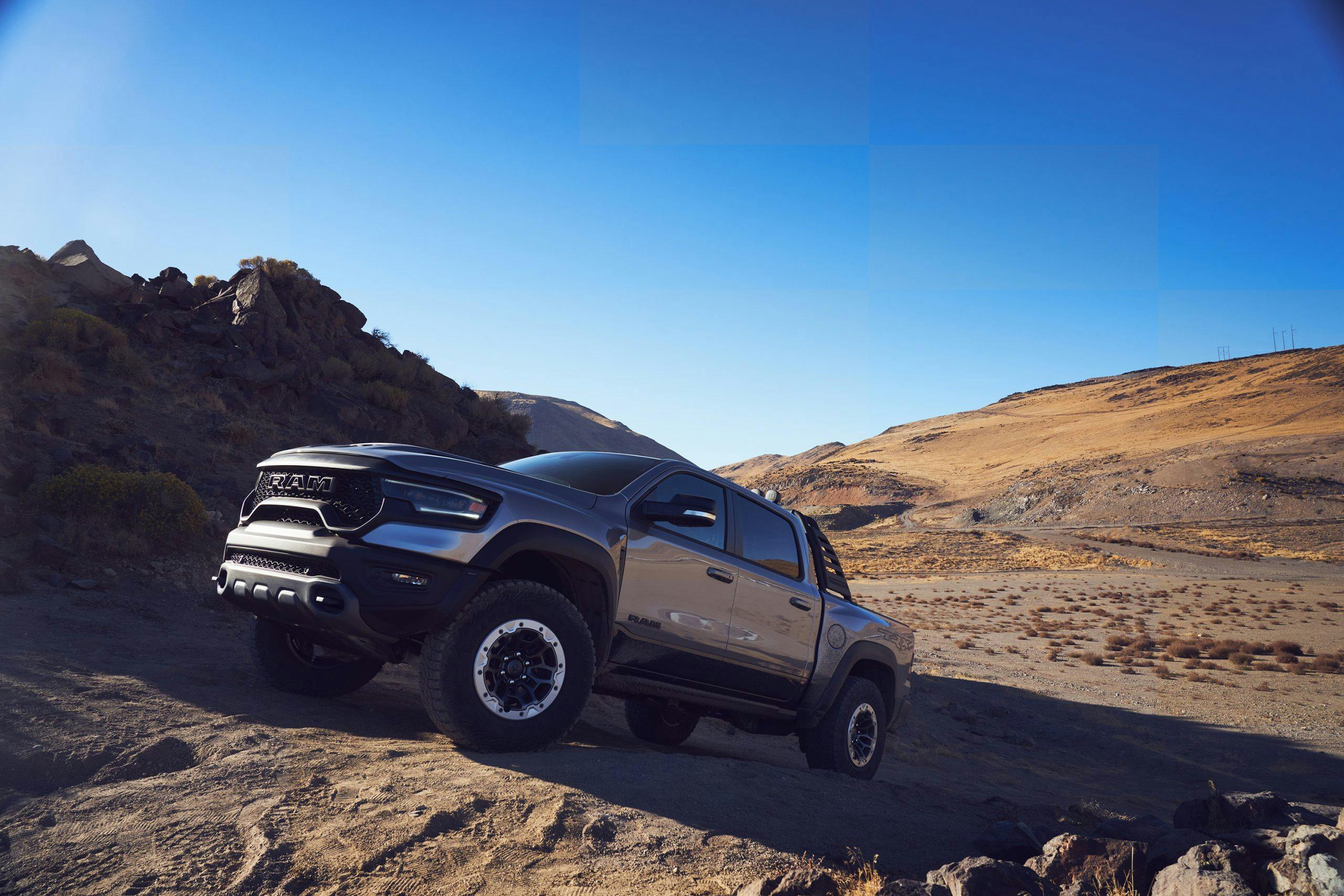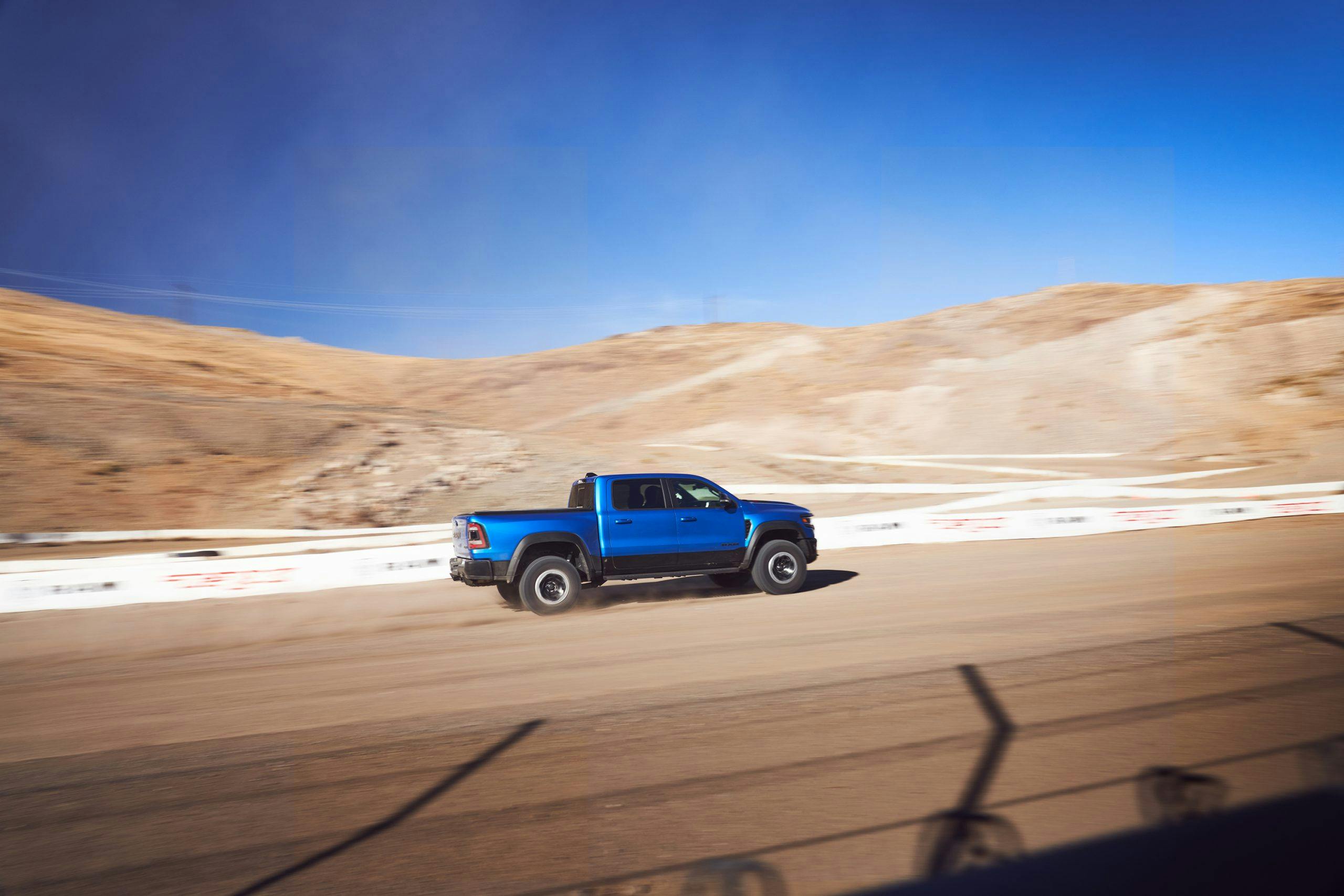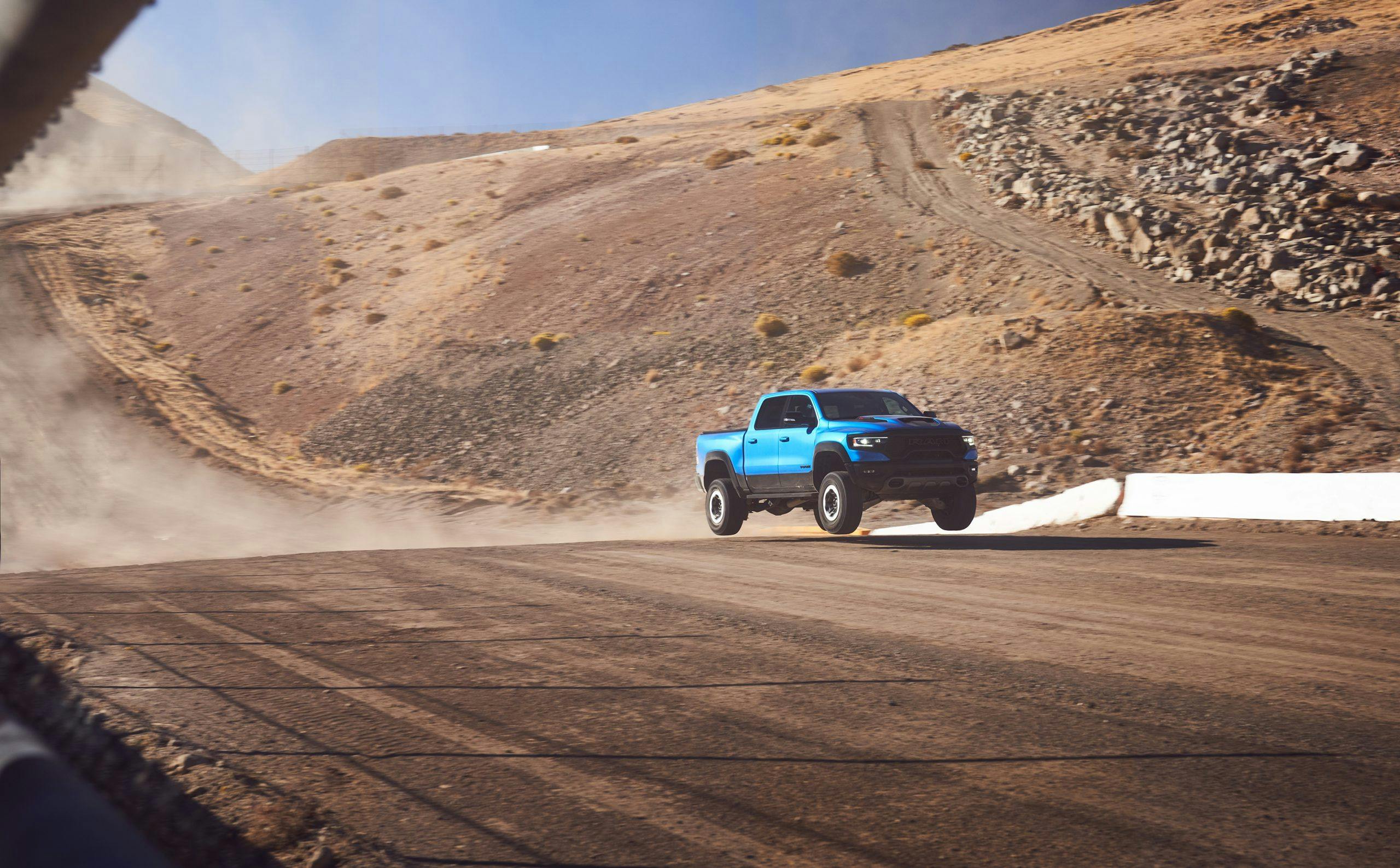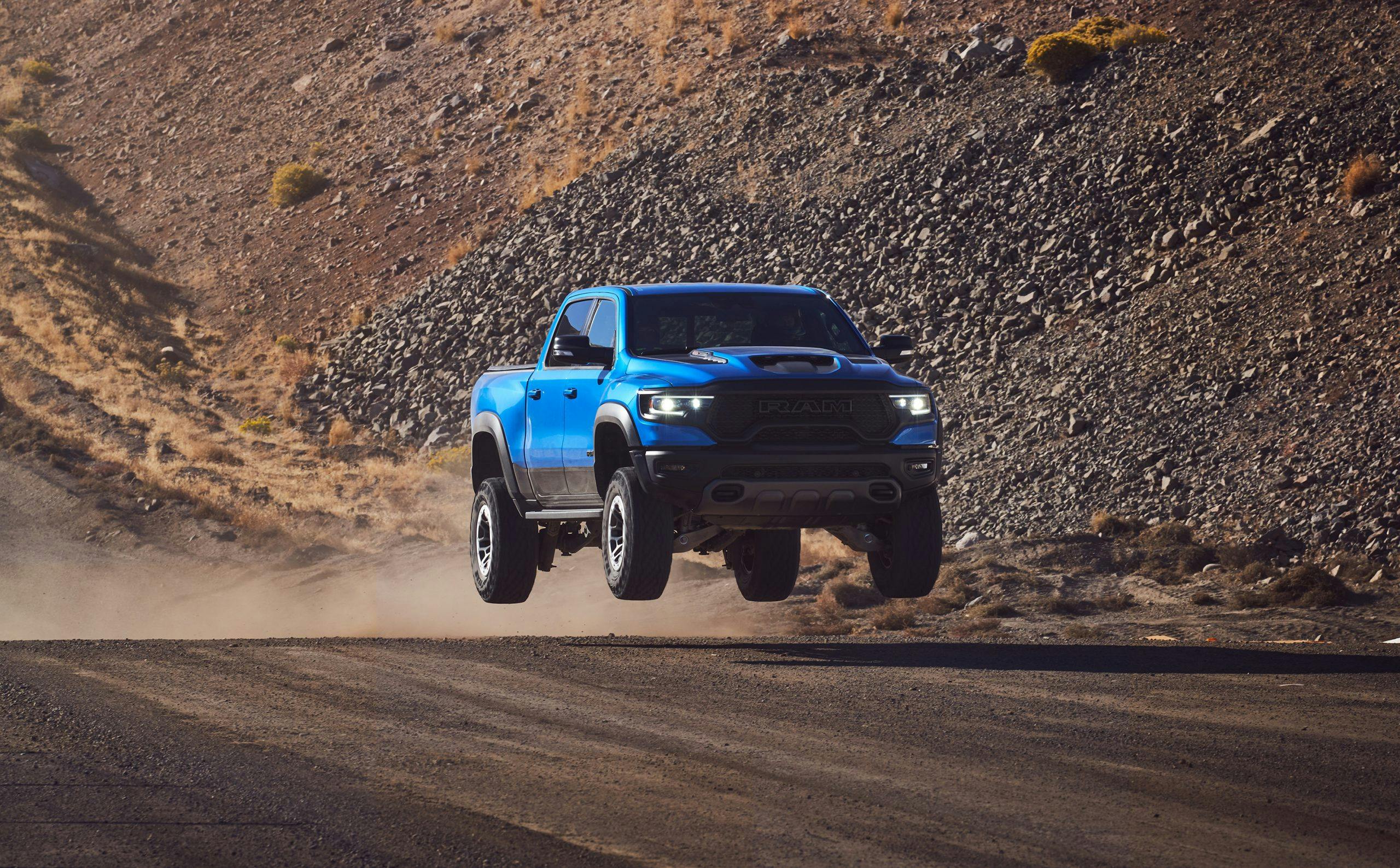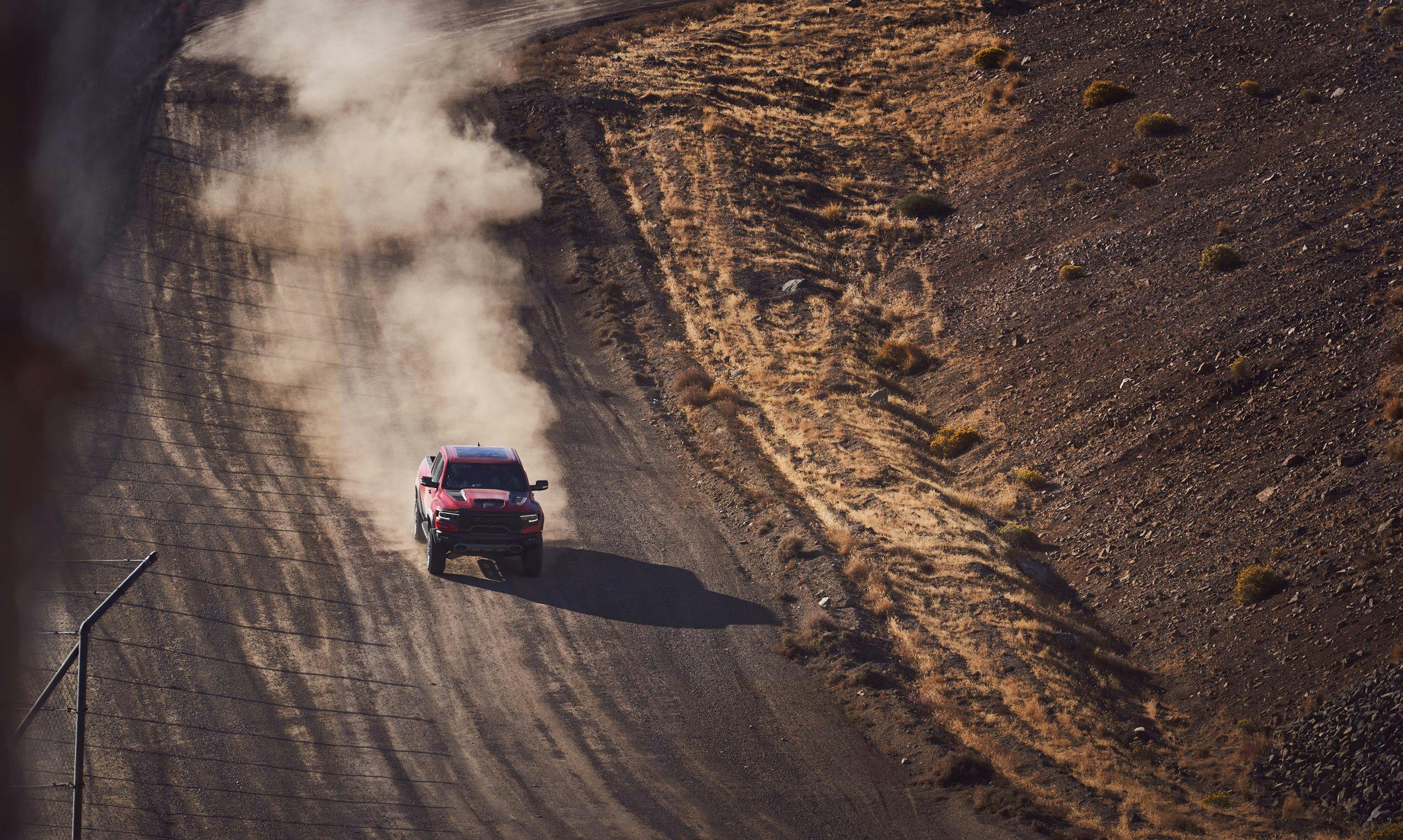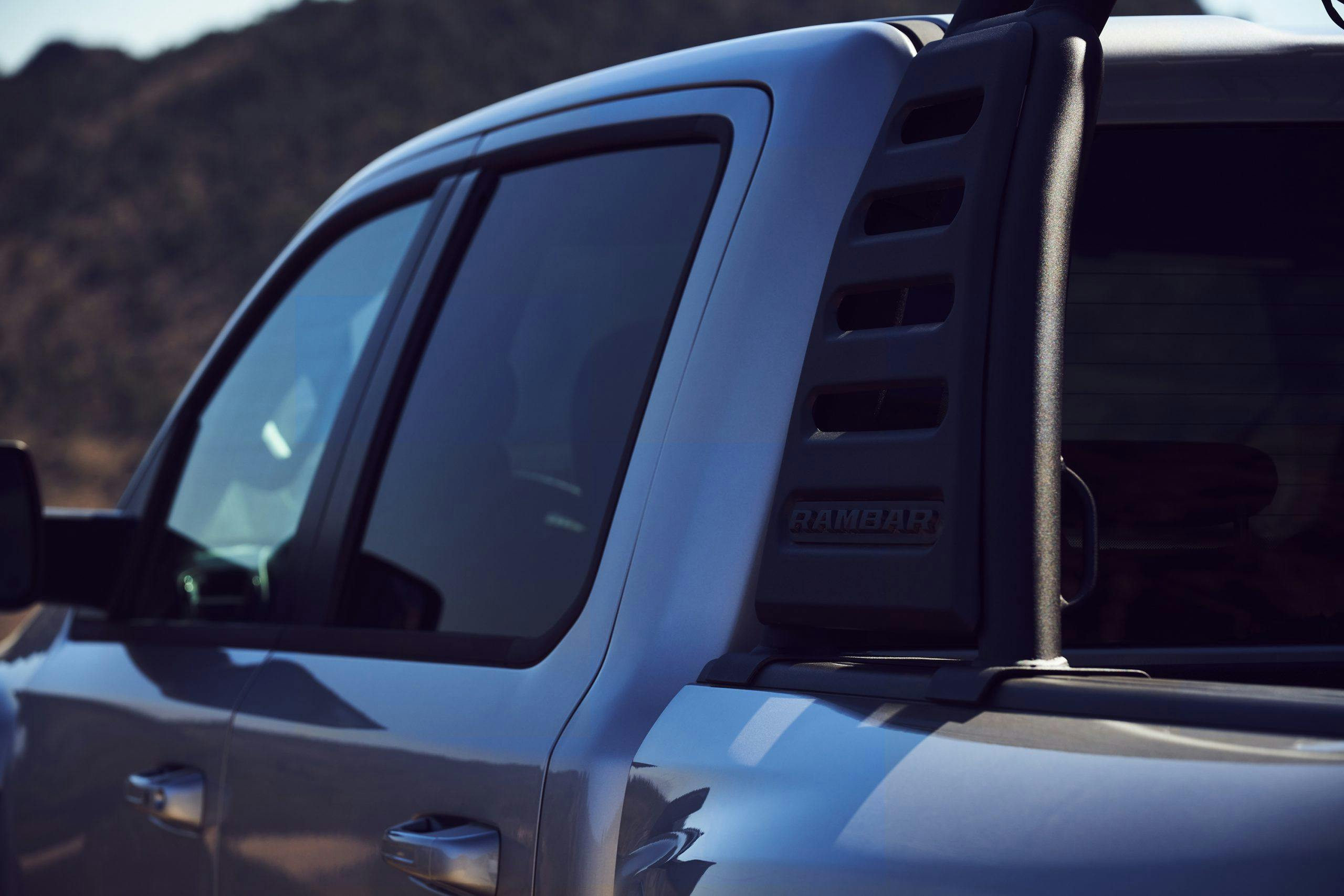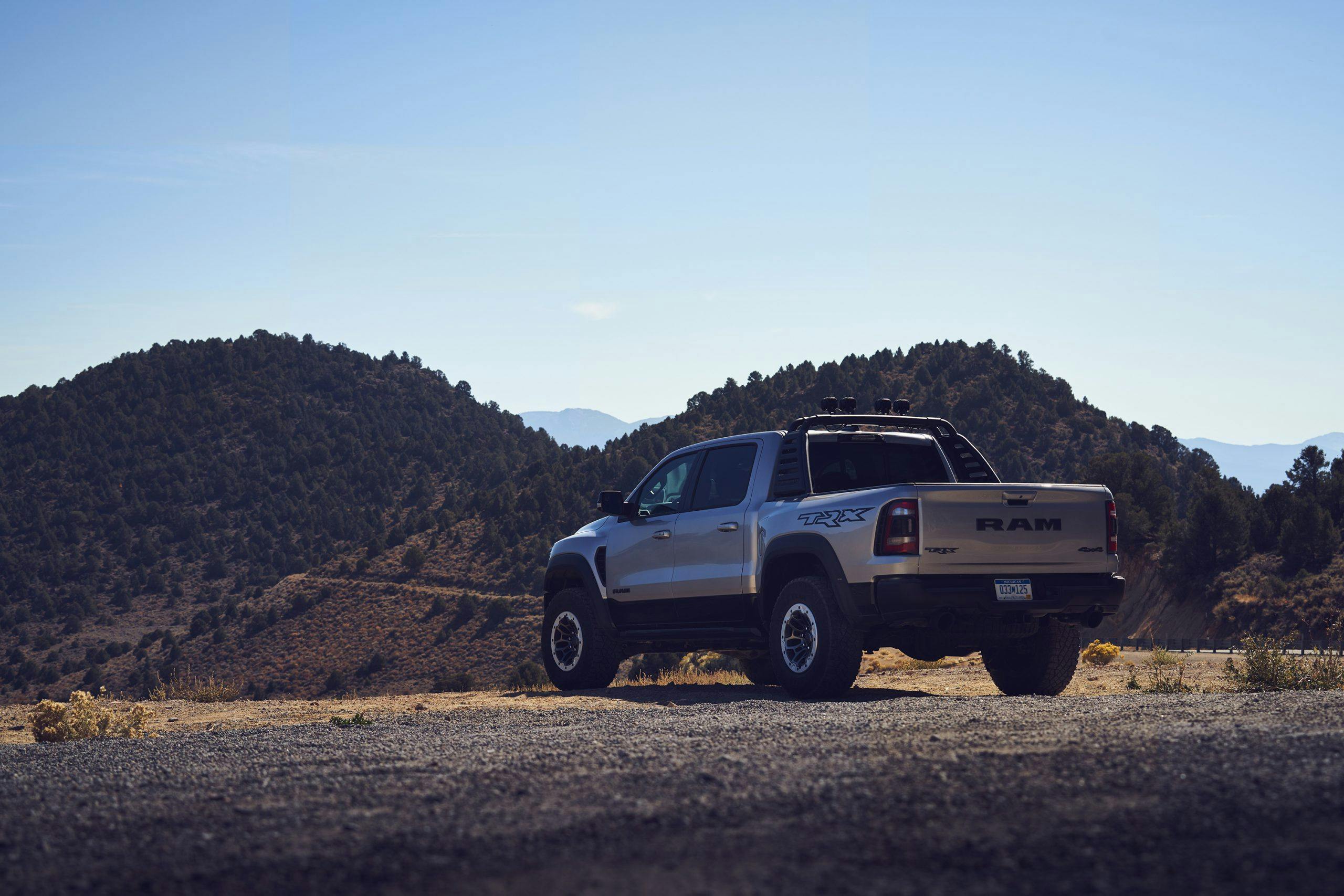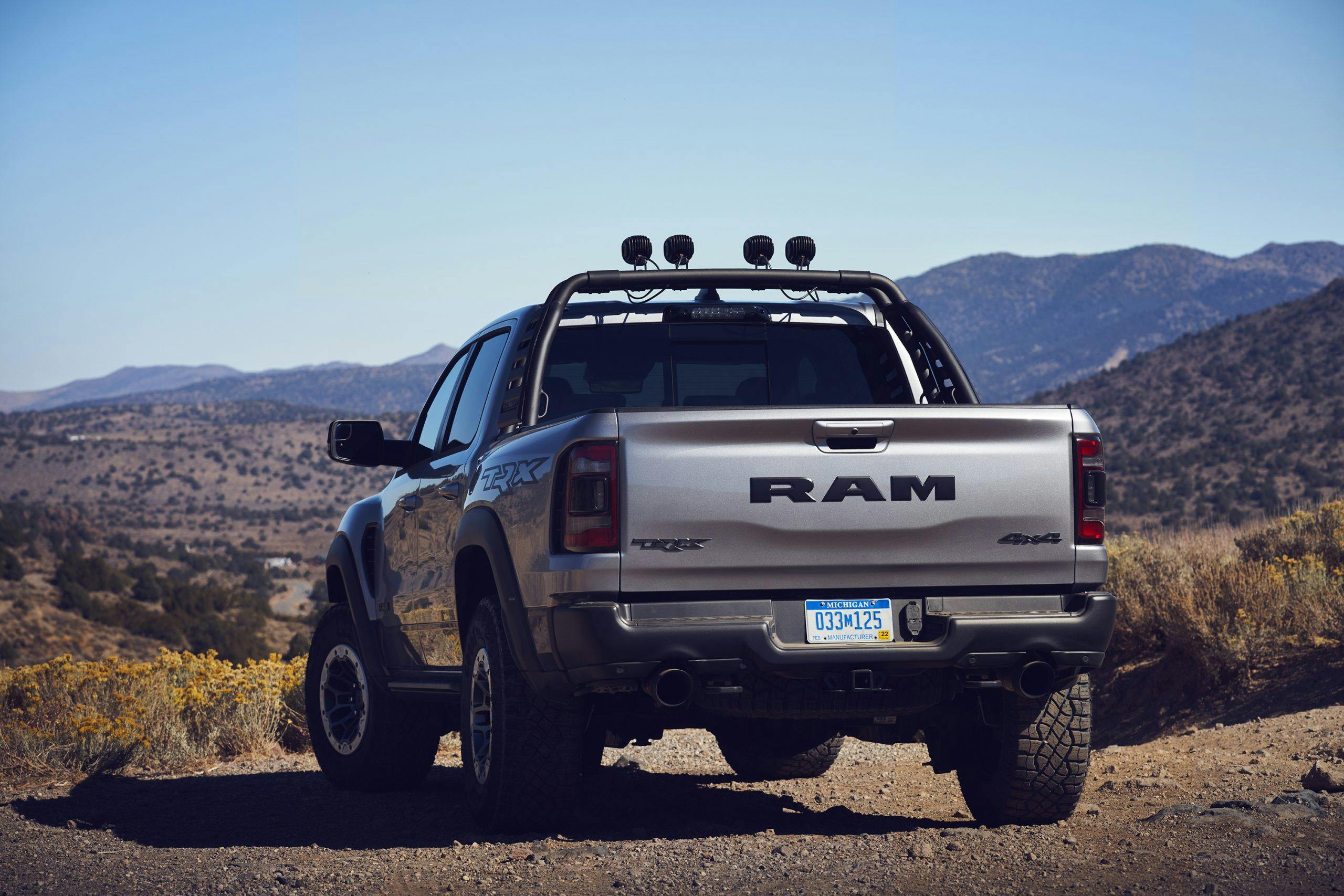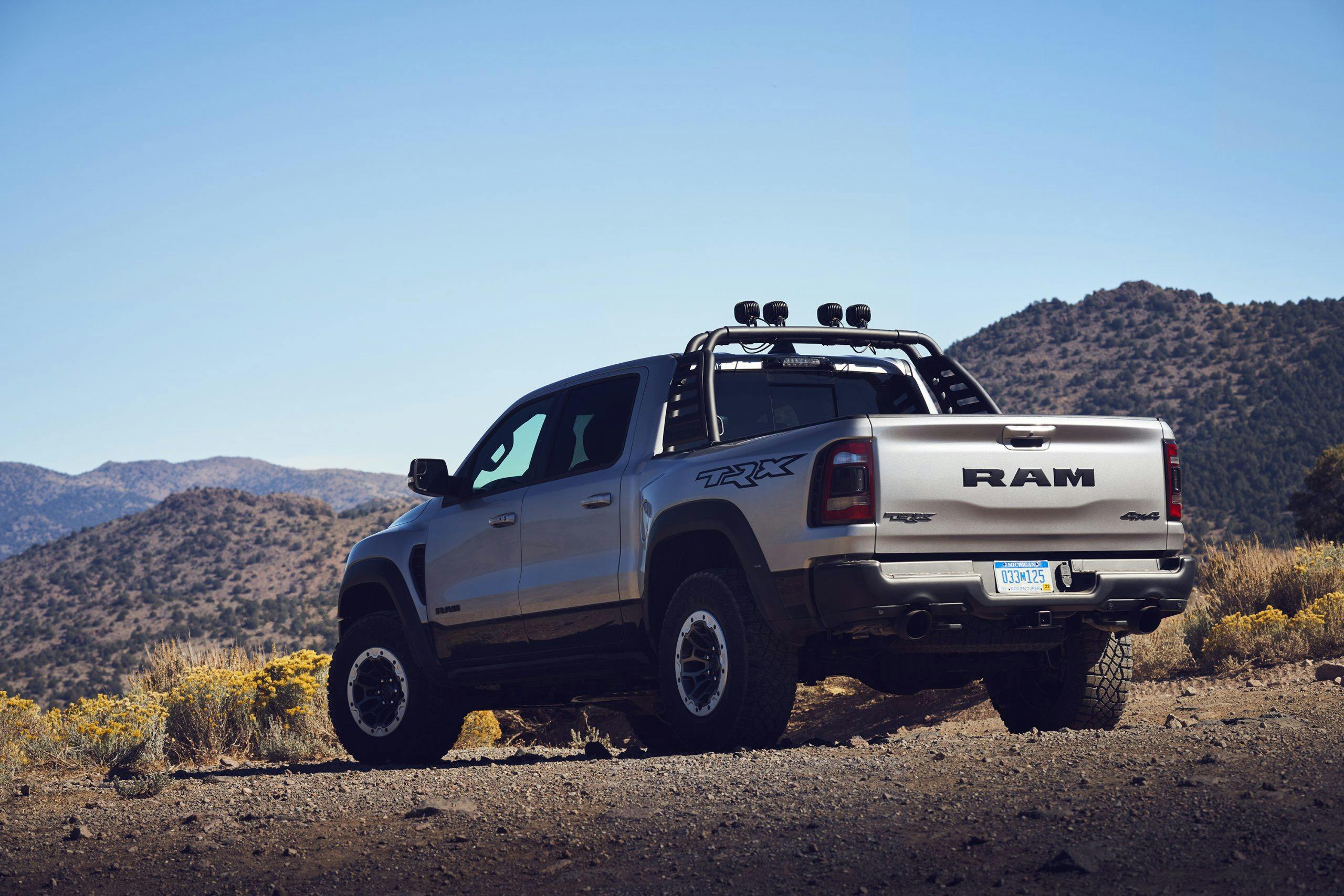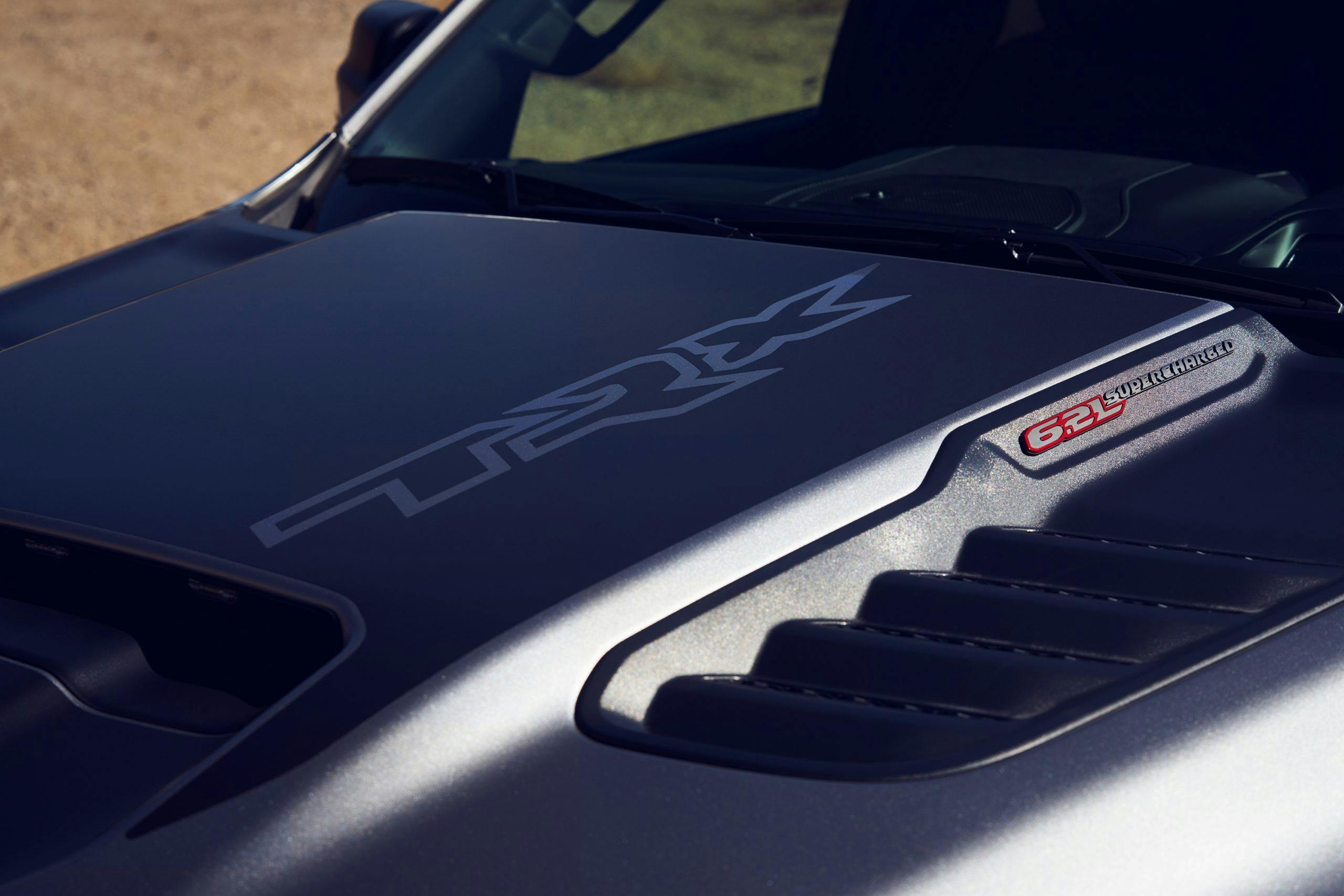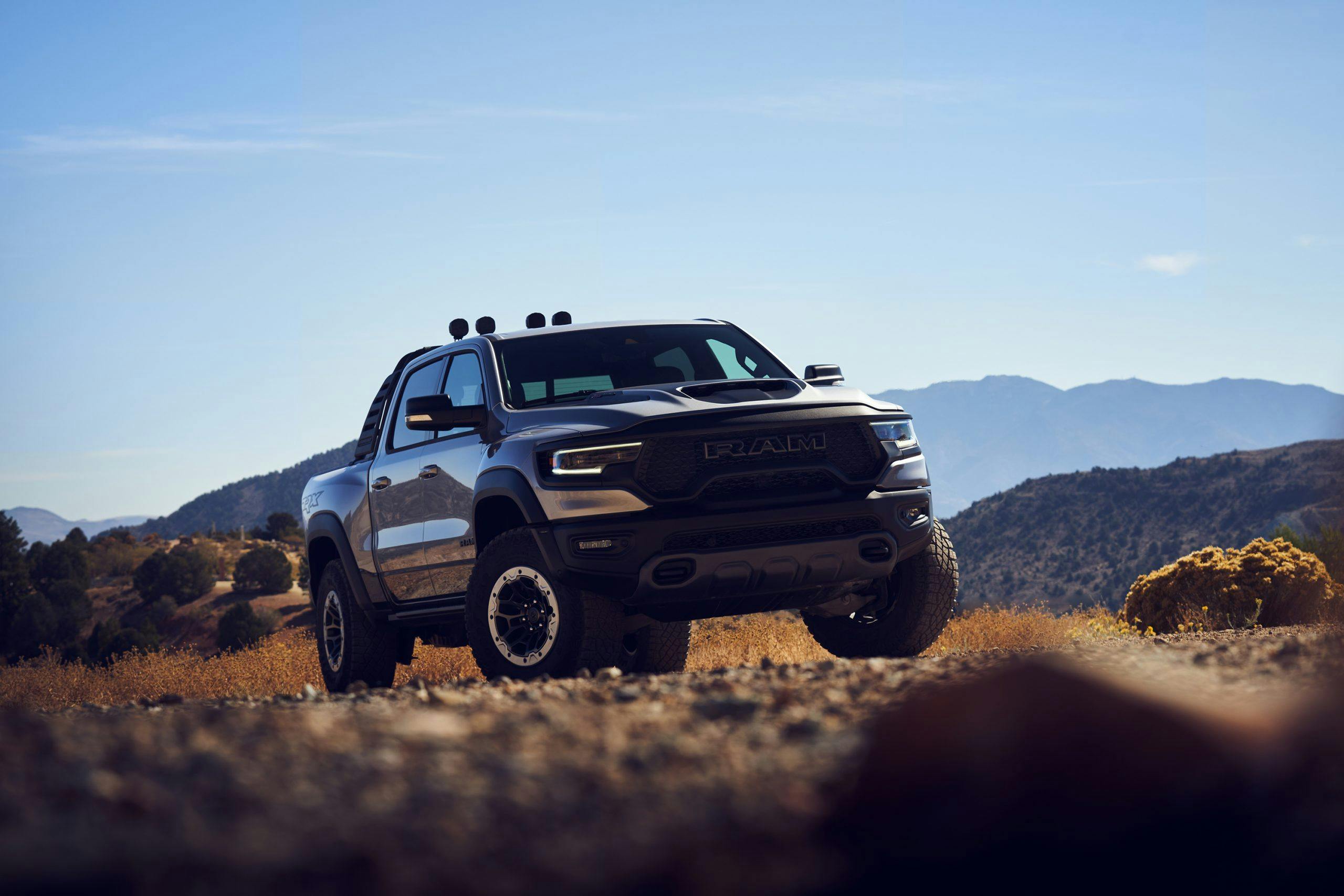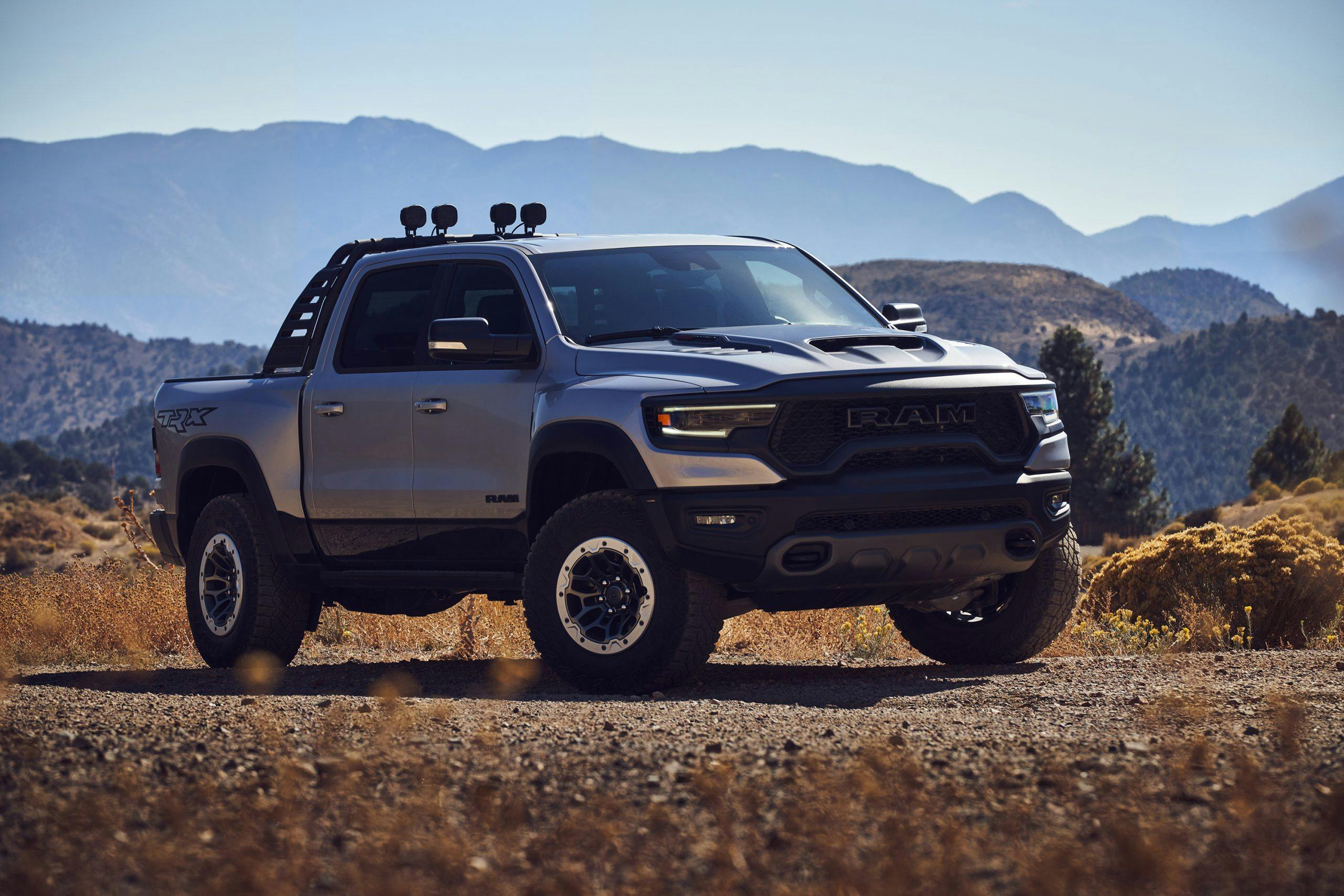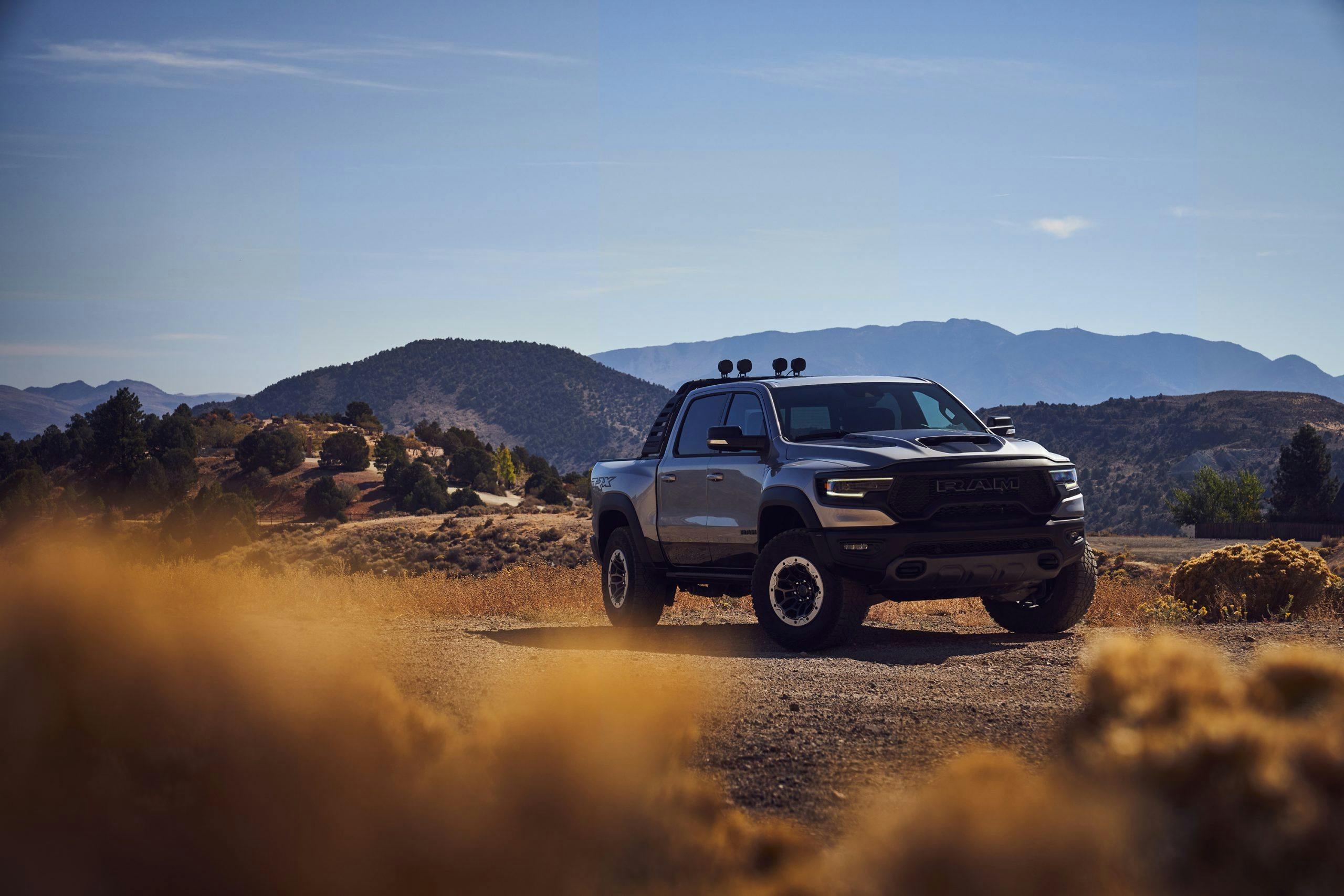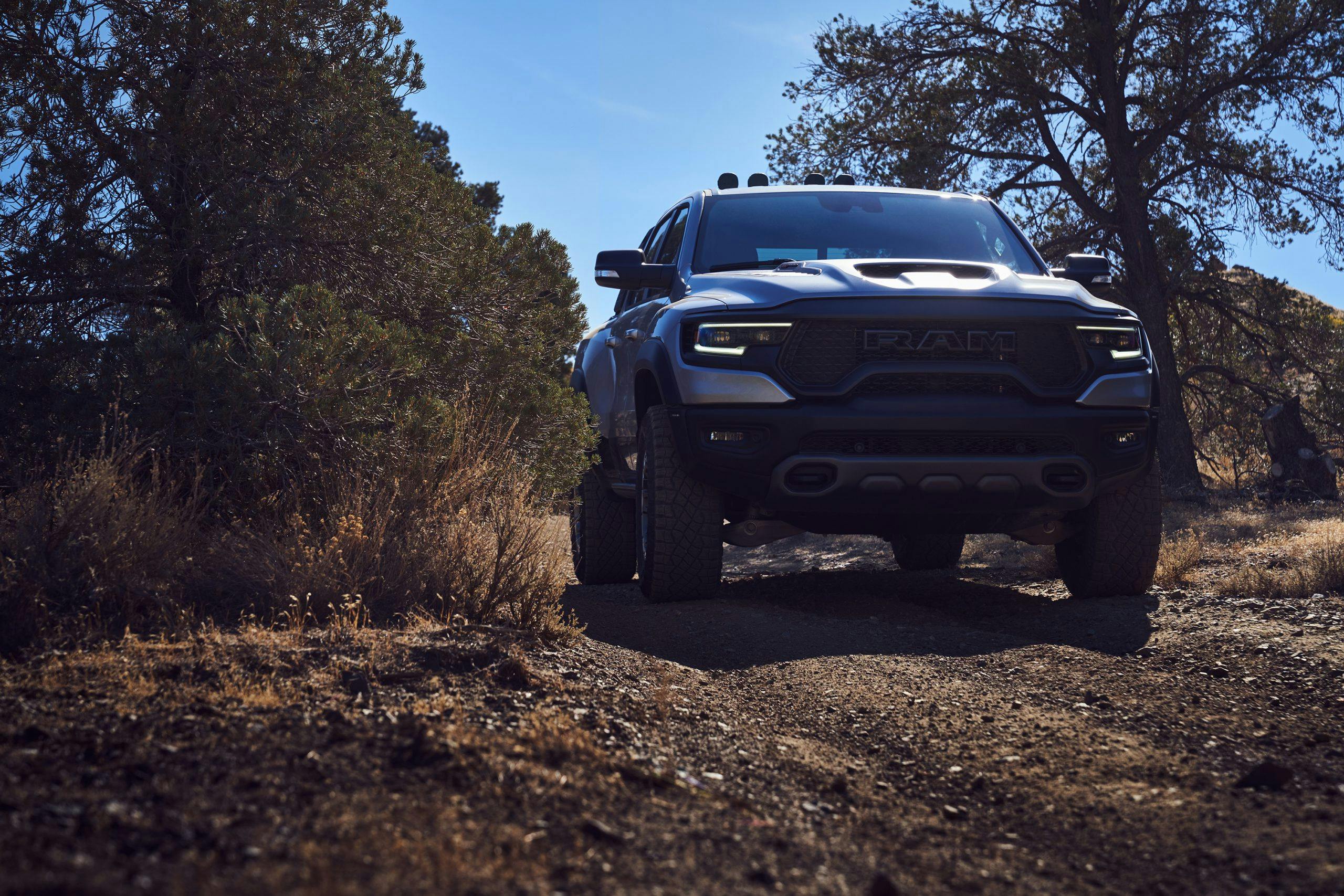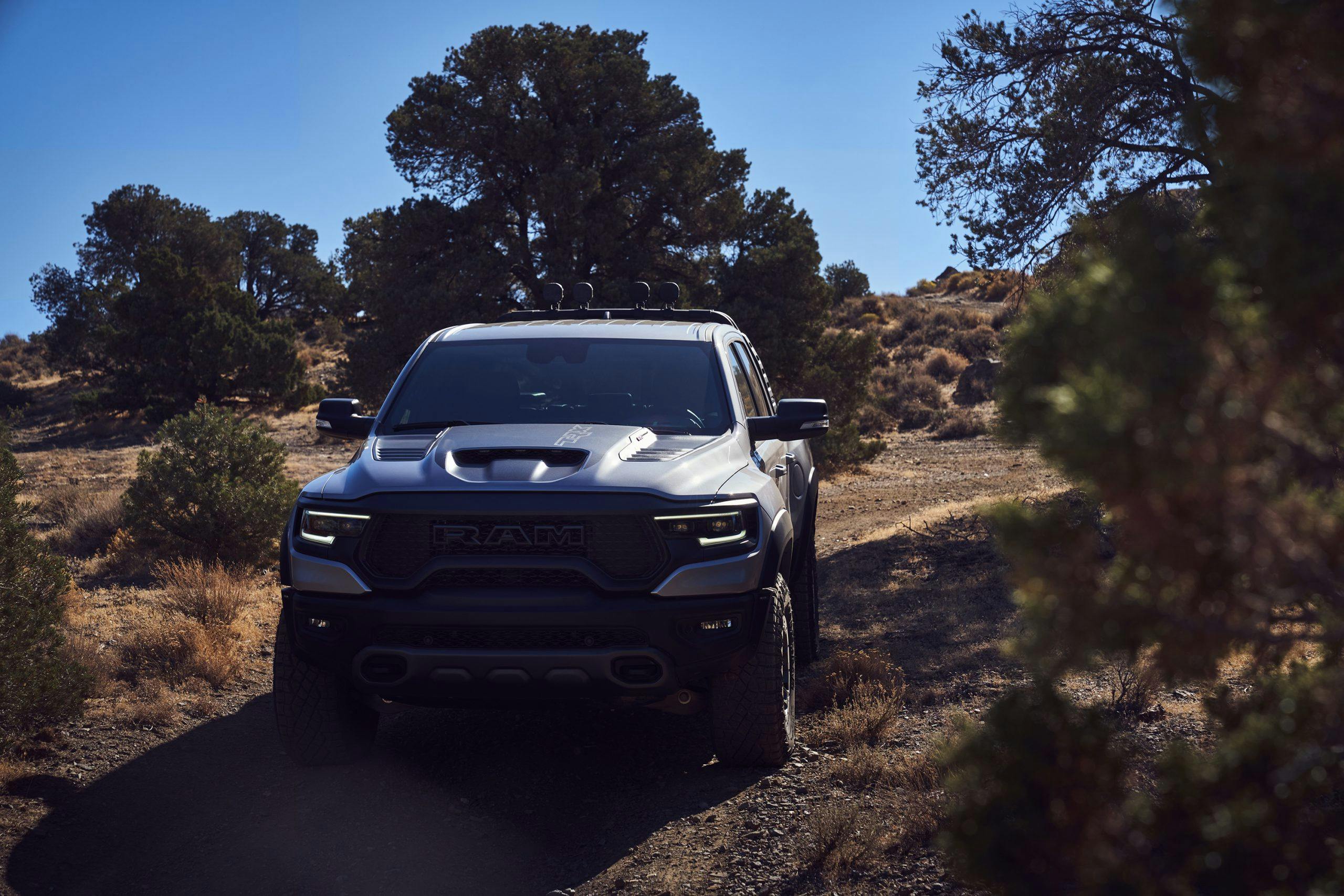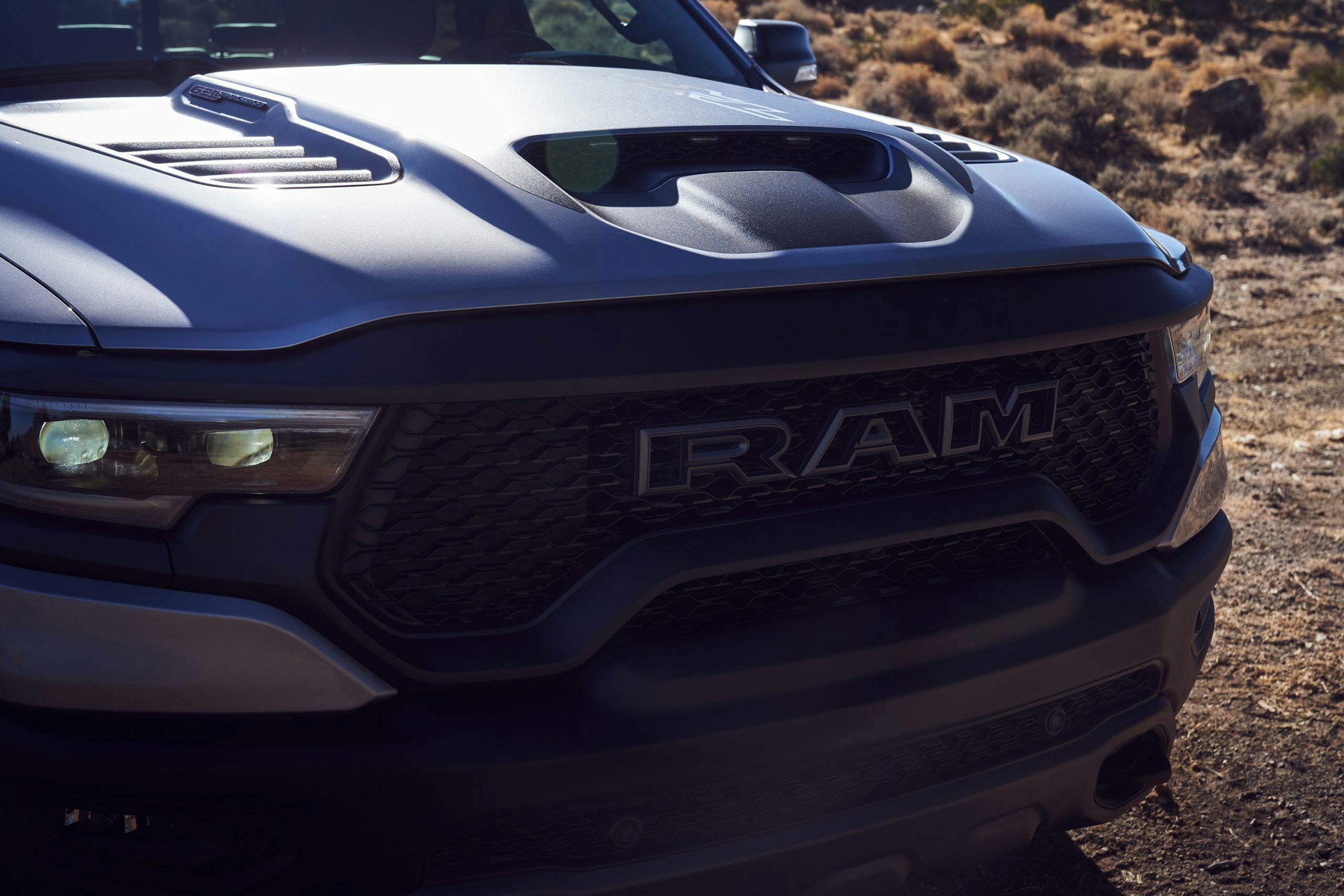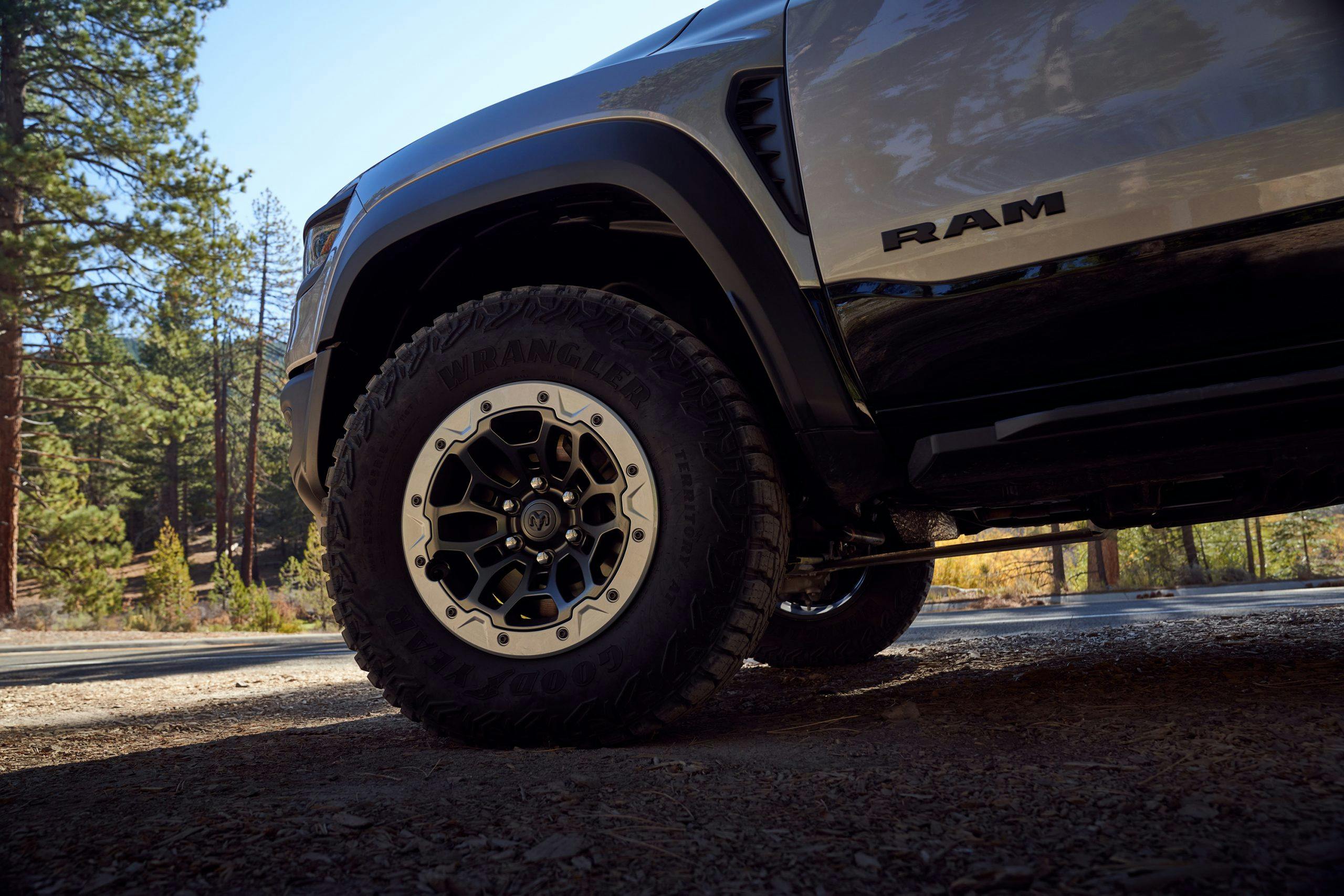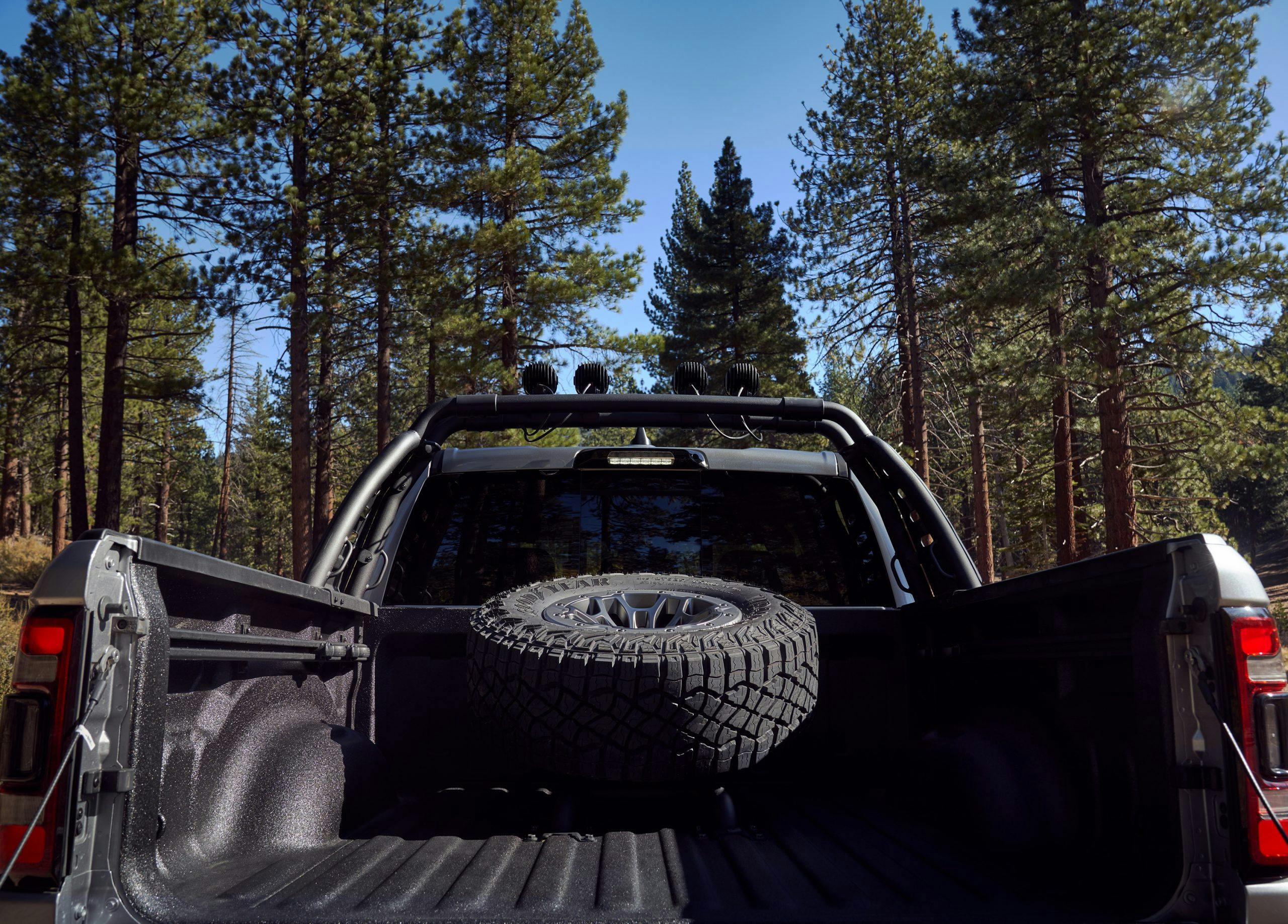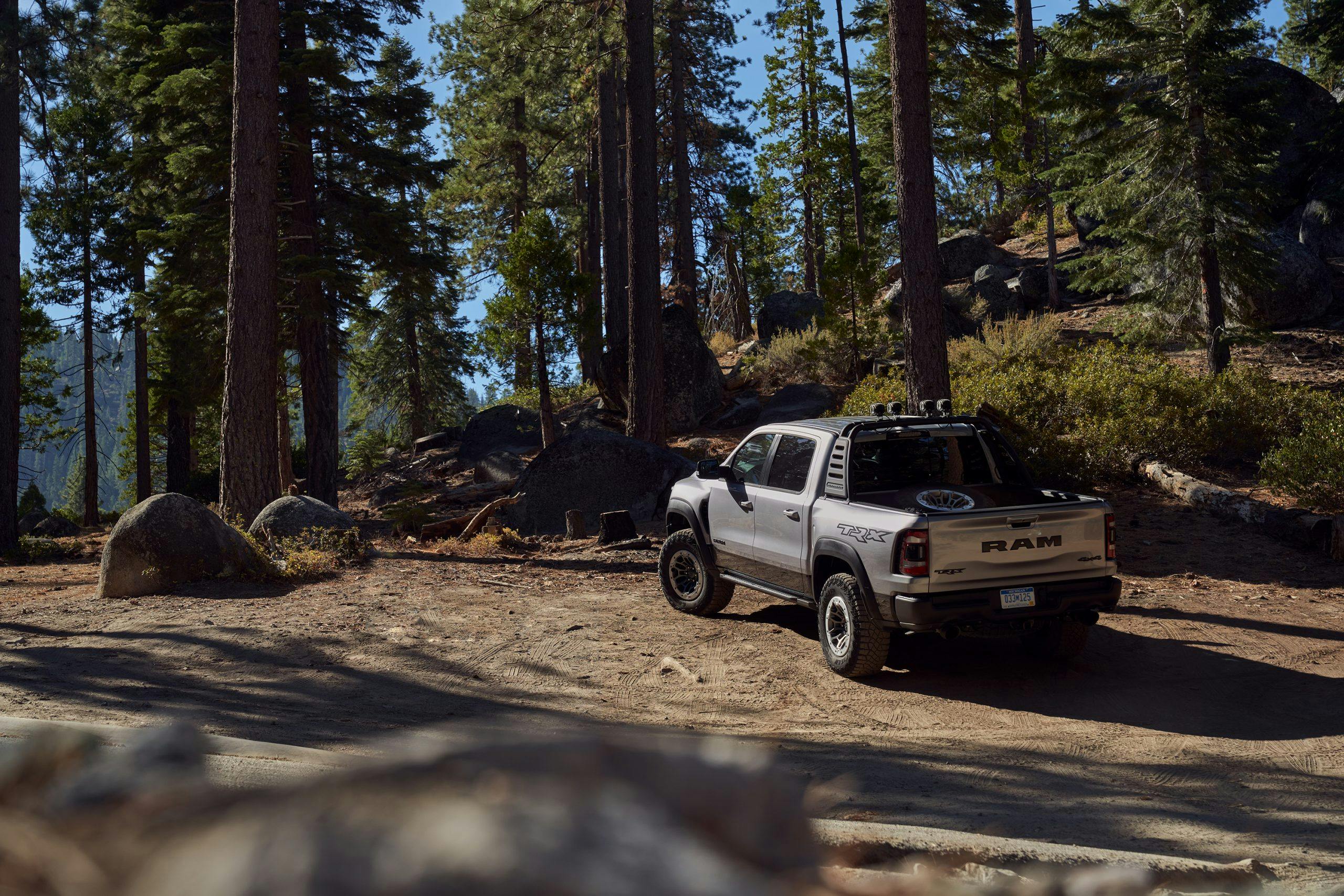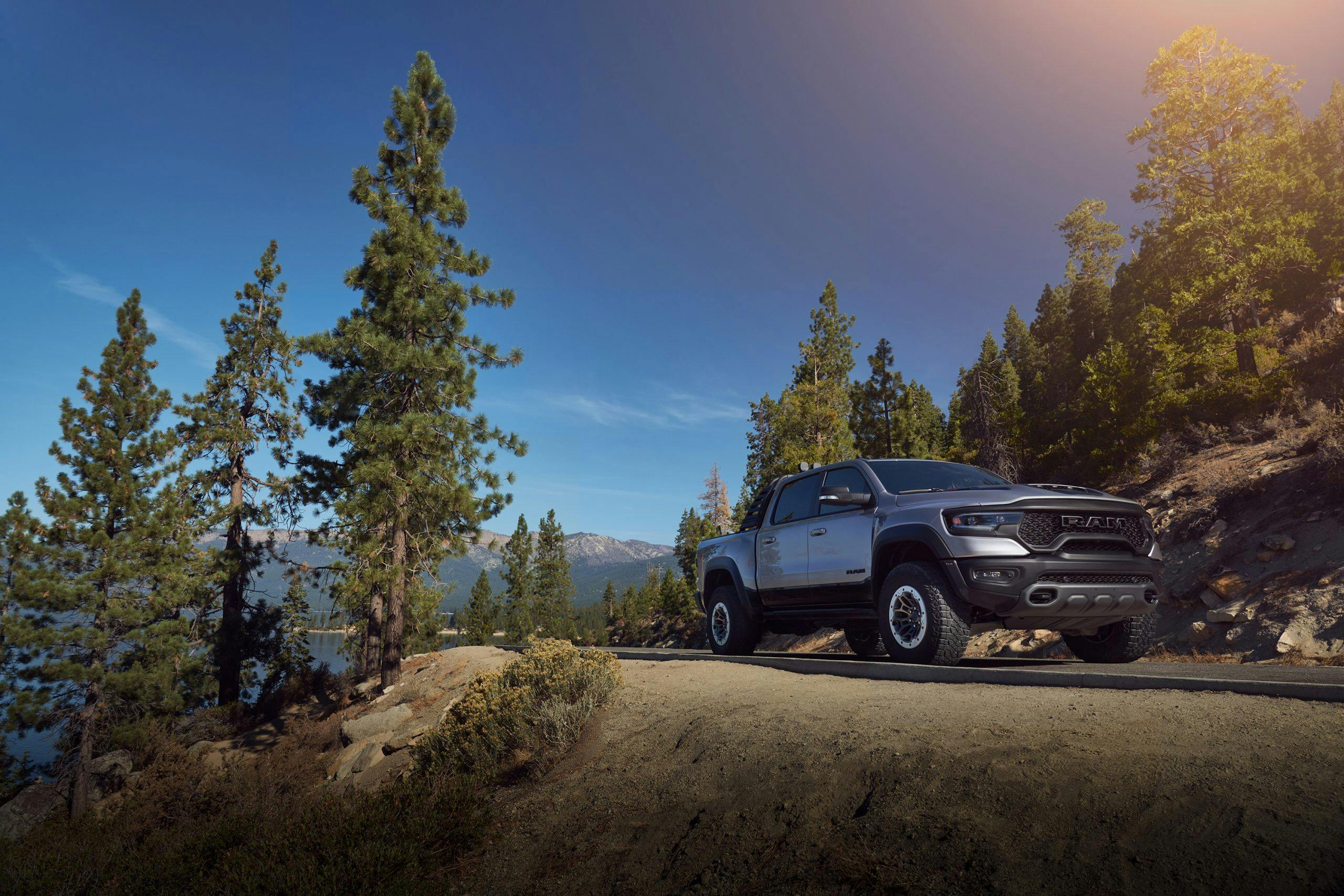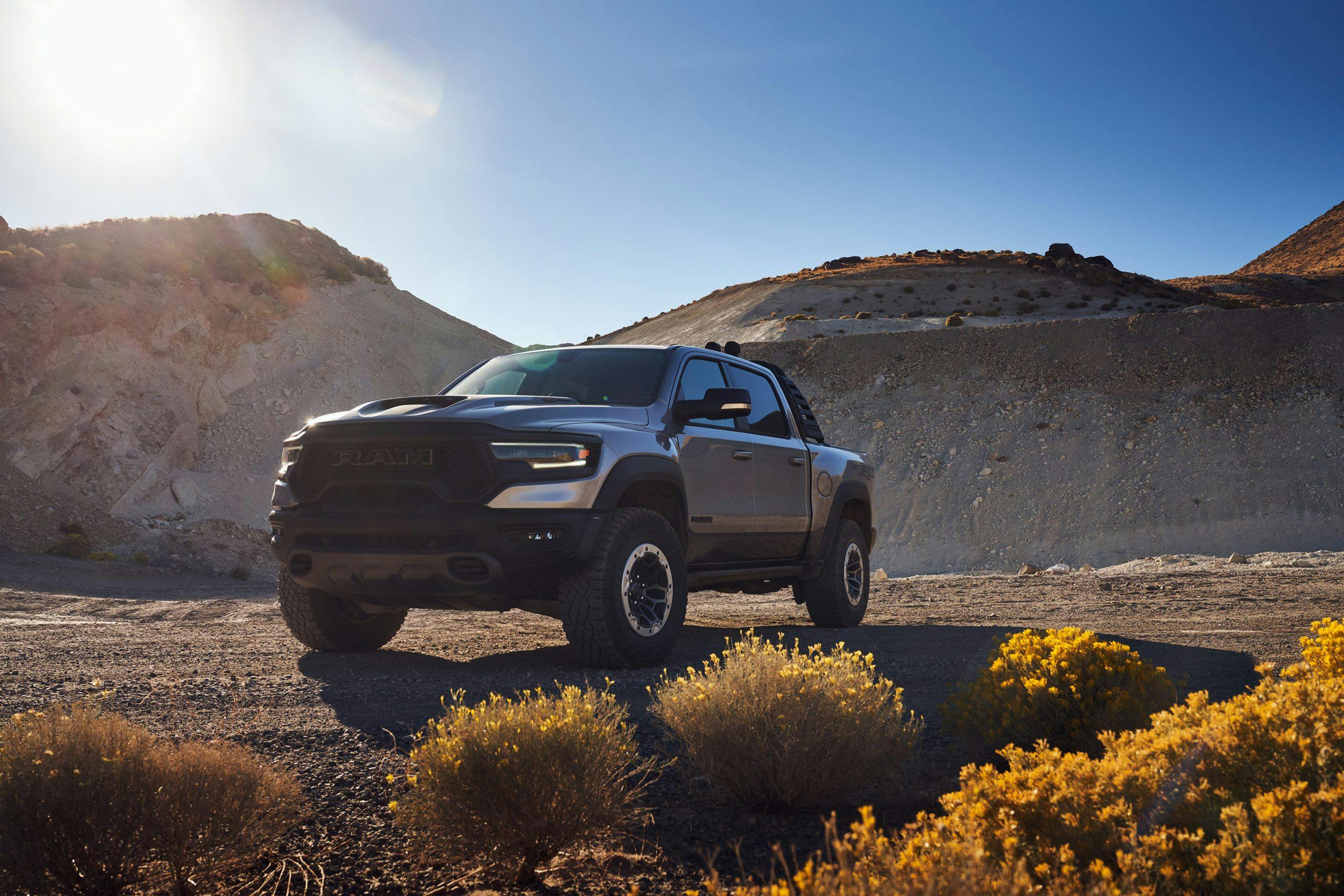Review: 2021 RAM 1500 TRX
Somewhere west of Laramie—west of Reno, even—the brake pedal of my new-for-2021, Hellcat-powered, flared-and-chaired Ram TRX went right to the floor. Smoke started rolling from the fenders as I hastily adjusted my plans for the next corner, which was coming up with all the alacrity a supercharged 6.2-liter V-8 could provide. That was more or less the end of my fast backroad drive in a three-ton, full-time-four-wheel-drive truck. Really, what did you expect? Yes, the 14.9-inch rotors and two-piston calipers probably represent an absolute high-water mark in standard-equipment half-ton pickup brakes—but applied to a vehicle of this size, they’re not exactly prepared to turn the TRX into an immovable object. Which means they’re bound to lose when confronted with … an irresistible force.

Why send a career automotive photographer to drive the new hyper-Ram on everything from a twisty two-lane to a 60-mph jump? Simple: I’m a committed owner of the current-generation Ford Raptor, the only possible natural enemy of the TRX. If there was fault to be found in this vehicle, I’d find it. Speaking truthfully, that turned out to be a tall order.
The TRX, too, is fairly tall—and more than fairly wide. Much like the Raptor is for the F-150, the TRX is an oversized beast. With its oversized fenders, the TRX is stretched side-to-side to 88 inches, up from 79.9 inches of the standard Ram Rebel; with nearly 12 inches of ground clearance and the 33-inch Goodyear Wranglers specifically developed for the TRX, this truck looks like it’s ready to Gravedigger anything in its path. However; the curviness of the truck and roundness of the fender-flares almost make it seem not quite as wide as it is. It doesn’t seem to have the presence of the Raptor because of this—the sharp character lines and wide box-flared fenders of the Raptor make it look like a Baja truck for the street. The TRX looks more like a factory truck that ate a few too many crossovers … if that makes any sense at all …
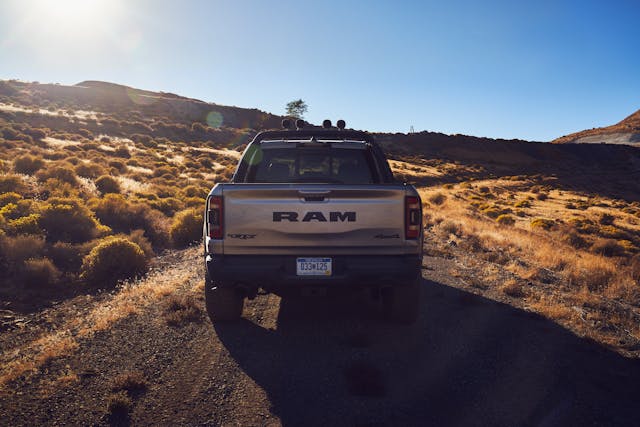
The factory rocksliders that run along the rockers actually have a little step built into them, to help heave yourself up and in. As I learned, each one of the sliders on the truck can support most of the weight of the truck independently. At 6300 pounds and change for a loaded TRX, that is not an easy task. My test TRX, its class-leading interior enhanced further by the one-with-everything TR2 package, is far more luxurious that even the most loaded-up Raptor. Even the dashboard is wrapped and stitched. Face it: 80 percent of these trucks probably won’t see dirt. Those buyers should absolutely pull the trigger on TR2, with its generous helping of Alcantara as far as the eye can see. The hard-core buyers will want the base interior, which is still more than enough to raise the eyebrow of your Lexus-owning neighbor.
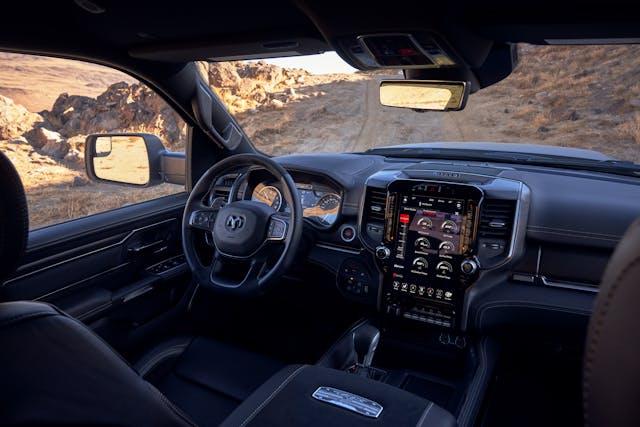
When you reach over and push that bright red start engine button, the infamous blown 6.2-liter HEMI roars to life. Despite the refinement of the cabin, the bark and grunt of the engine is heard, and felt, inside the truck. Ram engineers assured me that not a single bit of the sound is piped into the interior, as is the case with many modern cars. Instead it was a labor of love, tuning the sounds of the motor and exhaust to penetrate the cabin of the truck in just the right way. Special exhaust tubing, the smallest mufflers you have ever seen, a tuned X-Pipe—all things that contribute to the symphony that is this motor’s signature. Leading the orchestra is the twin-screw supercharger. As in the Hellcat sedans, the whine of the supercharger is unmistakable, and comes on at almost any throttle position. It actually seems like a waste that this truck has such a premium sound system, I think anyone in their right mind wouldn’t turn it on. As my Testarossa-driving father has pointed out to me on other vehicles: “The radio in this one is under the hood.”
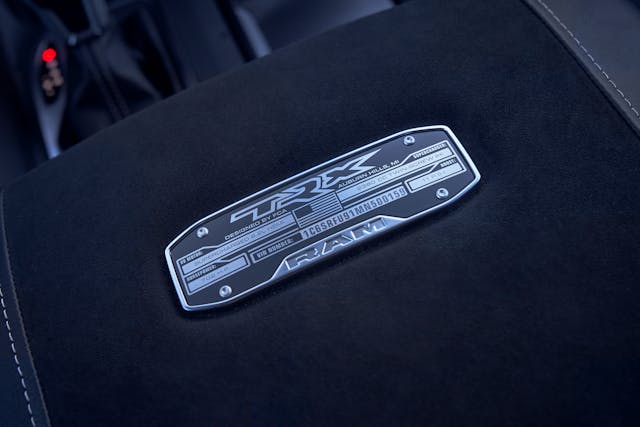
On the road, the TRX behaves with tremendous grace. It can make serious time on a back road—when was the last time you heard of a truck running out of brakes before it ran out of grip? And it’s not just capable on pavement; it’s genuinely comfortable. No wonder I let myself get a little too enthusiastic between corners. Having basically ignited the brakes during the aforementioned backroad drive, though, I eventually backed off the throttle and followed our test group to a Baja-style adventure course. We aired down the tires of the truck, about 10 psi down from the normal pressures, and I put on my Hans-device and helmet and hopped into the truck. Upon entering the track, as I blasted down the hill to the first jump, I was advised to keep the speed around 55–60 mph at the jumps to avoid drama. The truck jumped effortlessly; you wouldn’t expect an object this large to land so softly every time, but it was similar to falling into a pile of pillows, courtesy of the longest springs fitted to any non-commercial production vehicle. The truck stayed straight and true, sailing through the air with ease. On the second lap we hit the whoops which immediately followed the second large jump on the front straight. I instinctively braced myself for impact upon approach, as they became a lot bigger as we rapidly approached. “Don’t lift!” the co-driver barked, and I reluctantly listened and prepared to correct the course of the truck once we started to skip over the whoops. It was no different feeling than driving down most any road in Michigan. The chassis engineering on this truck is phenomenal.

The next activity was a rock crawl up a boulder field on a very steep grade. As I approached this course, I chatted with the spotters and agreed to ignore my common sense, simply trusting the humans in the orange vests giving me hand signals up the course to plant my tires where they needed to be. I switched the truck into four-low, locked the axles, and placed the driving mode into Rock Crawling mode. As the truck dipped and dived, it crawled its way up the hill, again with almost too much ease. In a few instances I lost sight of the spotters despite their arms being stretched above their heads, still not high enough to be seen when the front of the truck was climbing over some of the largest rocks. In these cases, I quickly switched on the new forward-facing camera on the truck to see where the tires were pointed. At the end of it, I had only added a few new scrapes and dings to the underside of the truck, which, as it turns out, is very well-protected with a wide array of factory skid-plates guarding all of the important vulnerable bits underneath the truck.

After a quick bite to eat we aired the tires on my truck back up to spec and headed over to a short dirt (!) drag strip so we could test another new TRX-specific feature of the truck: Launch control. Pulling to the starting line, switching the mode back to sport, setting the RPM max for the launch on the center screen and activating the launch control was all simple. Forcing the brake pedal to the floor, I revved it to the limiter, dropped the brake pedal—and away I went. Hitting the end of the track in a flash, again with no drama, no wheel spin, nothing. It was as if we were on asphalt or tarmac. The fact we were on dirt and the truck hooked like that was insane. The engineer from Ram told me that earlier in the week they set a time of 5.1 seconds to 60 using launch control on this very strip of dirt and gravel, which is BONKERS. After running this strip a few times, I got the feeling they hadn’t had to try all that hard at it.

After this run, I packed up my things and headed off into the desert to capture the rest of the photos and spend more time behind the wheel. It is worth noting that during said time, I treated the Ram more or less the way I treat my Raptor. I pushed the truck hard, kept it in boost most of the time. Over the 200+ miles of driving the TRX my average fuel numbers were a bit, well … I got 8.6 mpg combined across dirt, highway, and two-lane mountain roads. The last time I saw a mileage figure like that, I was driving an AMG G63. Not that the owners will care. Economy wasn’t even a thought that crossed my mind when I was hunting for the Raptor, and I don’t complain too much about the 14.5 mpg I see in that on a daily basis.

The TRX is a hell of a machine. It can conquer any environment you can throw at it, err … well, maybe it’s not that manageable in a dense urban environment, but you get the idea. The chassis dynamics are astounding, and the Hellcat engine is right at home in this monster of a truck. If anything, this engine seems more fitting in this truck that it does in the Challenger. This truck was engineered to run, and run fast. The engineers claim it is purpose-built for desert operation at speeds over 100 mph and that it was torture-tested during development to ensure it could handle anything the consumer would throw at it.

There are a few areas that could use enhancement. The shifter paddles require some concentration to use, as they’re hollowed out where a driver would normally touch them. The reason? To make space for the FCA-standard radio control buttons. There are far more “drive modes” than any actual owner will need, or use. The center display can be configured to show a lot of fascinating information … that will take your eyes and your attention as far off-road as the TRX can get under full boost. Placing the spare tire in the bed significantly reduces the utility of the truck as a whole.

Given that most of these T-Rexes will live in the suburbs and the closest thing to off-roading they will see is the mulch-filled median at the local Whole Foods I would say it is probably over-engineered, which is never a bad thing. Is it better than a Raptor? Well … From a luxury standpoint? Sure. Design standpoint? The Raptor has more of a Baja look and is more dramatic to stare at than the TRX. It’s also hard to see exactly where all of the Ram’s 252-horse advantage went; it’s faster than the Raptor, but not tremendously so. Perhaps the extra twist is mostly used to push what is a fundamentally larger and heavier vehicle. Still, the TRX represents the first legitimate full-sized competition the Ford has faced, and that’s how the breed is improved.
2021 Ram 1500 TRX: $71,690 base, First Edition $90,265.
Pros: Fearsome pace on and off-road. Upscale interior. All the features one could imagine. Engineered for the apocalypse …
Cons: … as long as there’s a gas station open after the apocalypse. Some trims are too posh for the truck’s intended use. Close to S-Class money. So heavy that some of the Hellcat’s time-warping thrust is blunted. Highly unlikely to prove popular at your next Greenpeace meeting.
Summary: More of a Raptor competitor than an outright Raptor killer, the TRX takes the American half-ton well beyond its logical extreme and proves that William Blake was, in fact right: the road of excess leads to the palace of wisdom.
Check out Andrew’s super-sized TRX gallery below.
